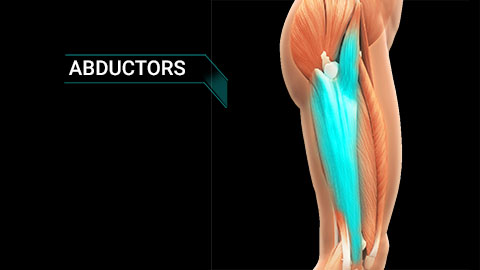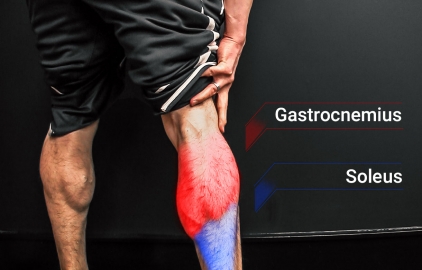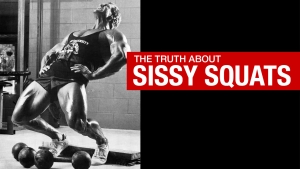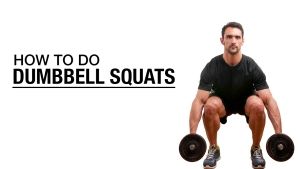
THE ULTIMATE LEG WORKOUT GUIDE
Most people think that as long as their leg day workout routine includes exercises for the quadriceps and hamstrings, they are good to go. Mission accomplished, right?
Not even close.
So, what is the best workout for legs?
There is a LOT more to leg training than you may think, especially if you’re a hard gainer with a pair of chicken legs.
When it comes to training legs, you don’t need to perform dozens of leg exercises, but you need to know what exercises to choose to see the best results.
Here’s a breakdown of what you’ll get in this complete guide to leg day workout routines:
This step-by-step guide is broken down into sections to help you find exactly the information you’re looking for.
I’ll also be answering some commonly asked questions related to leg exercises and leg day workouts including can leg workouts make you faster, what are the best leg workouts for knees, and how to do leg exercises with a pair of dumbbells and best beginner leg workout.
Let’s get to it!
1) LEG MUSCLE ANATOMY
The quads, hamstrings, adductors, and abductors are all important major muscle groups in the legs that can be targeted with leg workouts at the gym or leg workouts at home.
As always, I’ll help you understand the anatomy of the legs with my trusty Muscle Markers.
THE QUADRICEPS
The Quadriceps muscles are the largest major muscles in the legs and they have four heads or sections:
VASTUS MEDIALIS

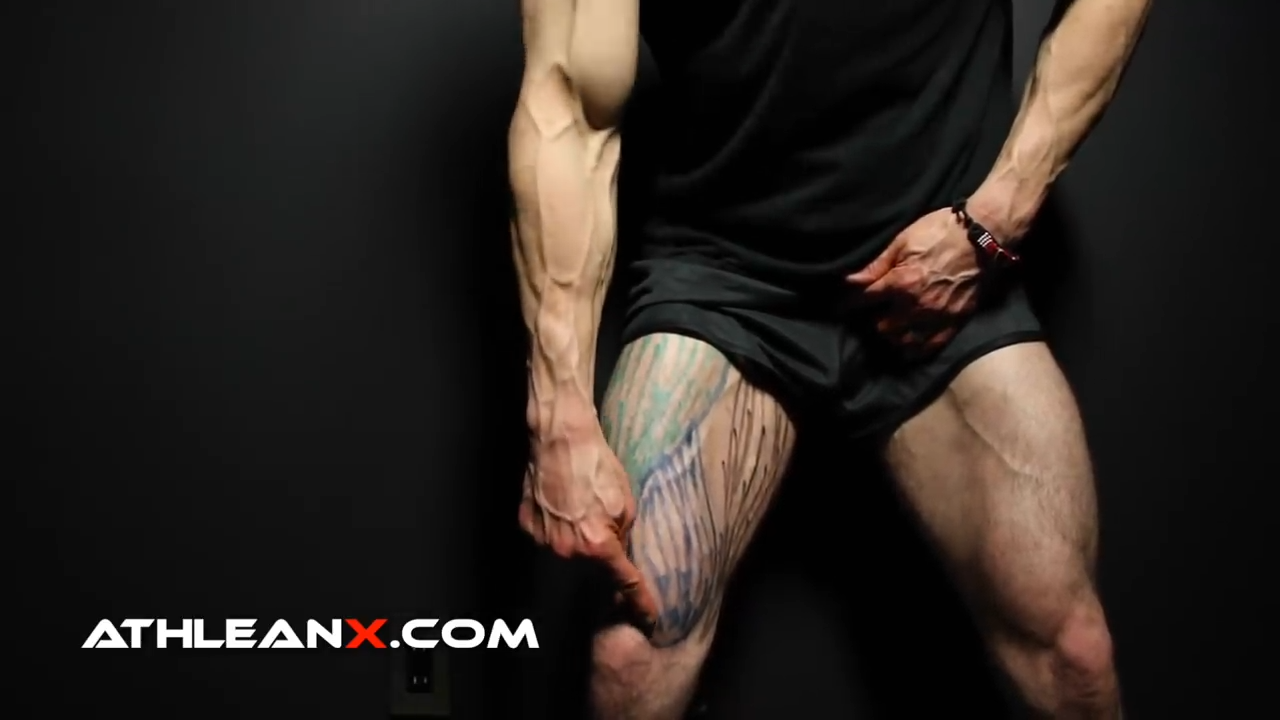
On the inside of the knee, you’ll find the Vastus Medialis. This is the medial component of the quad and its primary function is to help with knee extension.
VASTUS INTERMEDIUS

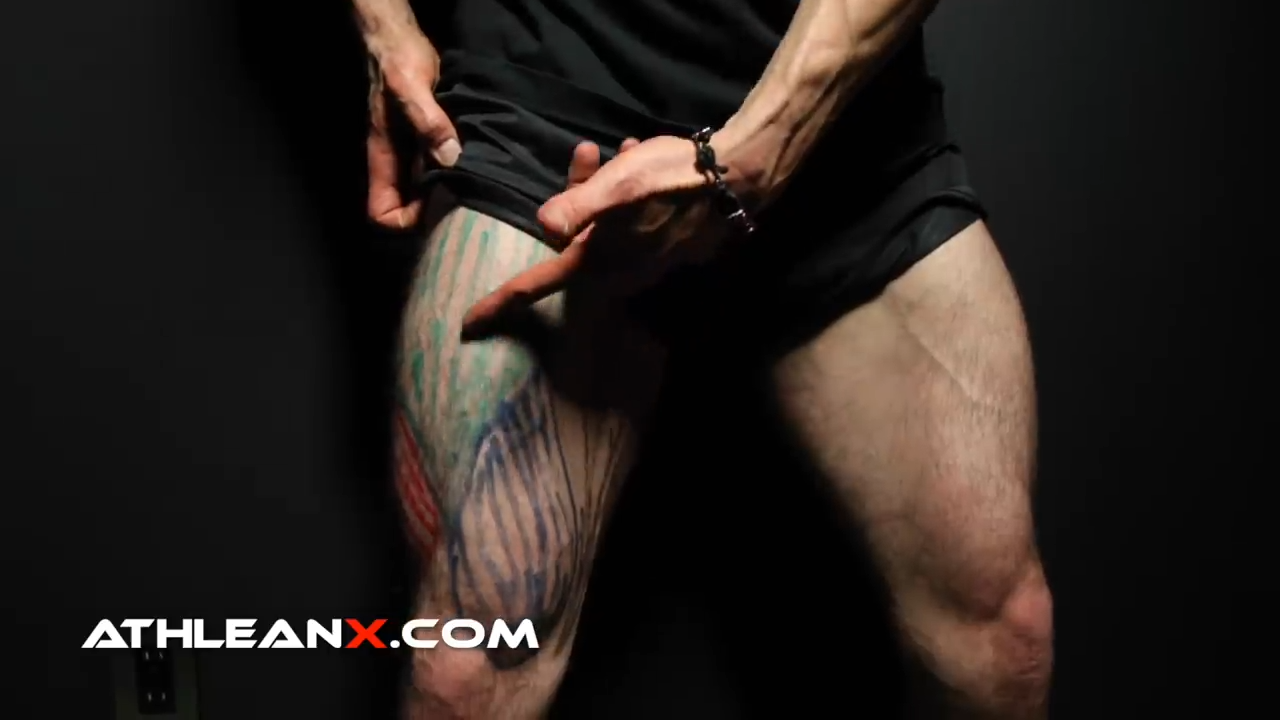
You can’t see the Vastus Intermedius, but I promise you it’s there, right in the middle of the quad. This section is also involved in the extension of the knee.
VASTUS LATERALIS

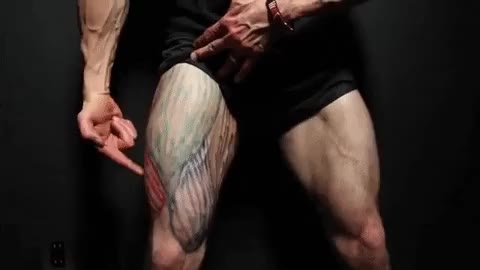
On the outside of the thigh is the Vastus Lateralis and just like the others, it helps with knee extension.
RECTUS FEMORIS

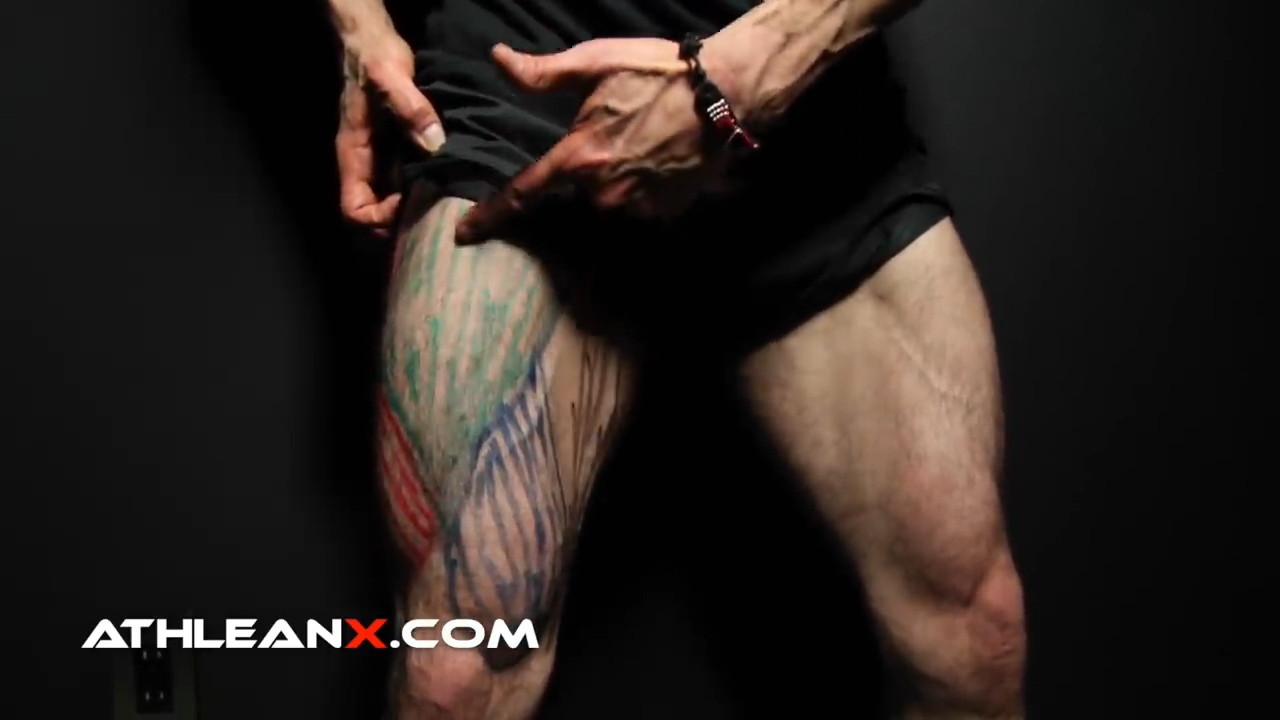
The only component of the quadriceps muscle that has an attachment above the hip is the rectus femoris muscle. That means it helps with hip function, particularly the hips ability to lift you into flexion.
THE HAMSTRINGS
Flip to the posterior muscles on the back of your legs, and that’s where you’ll find the hamstring muscles. These powerful muscles have two main sections:
BICEPS FEMORIS

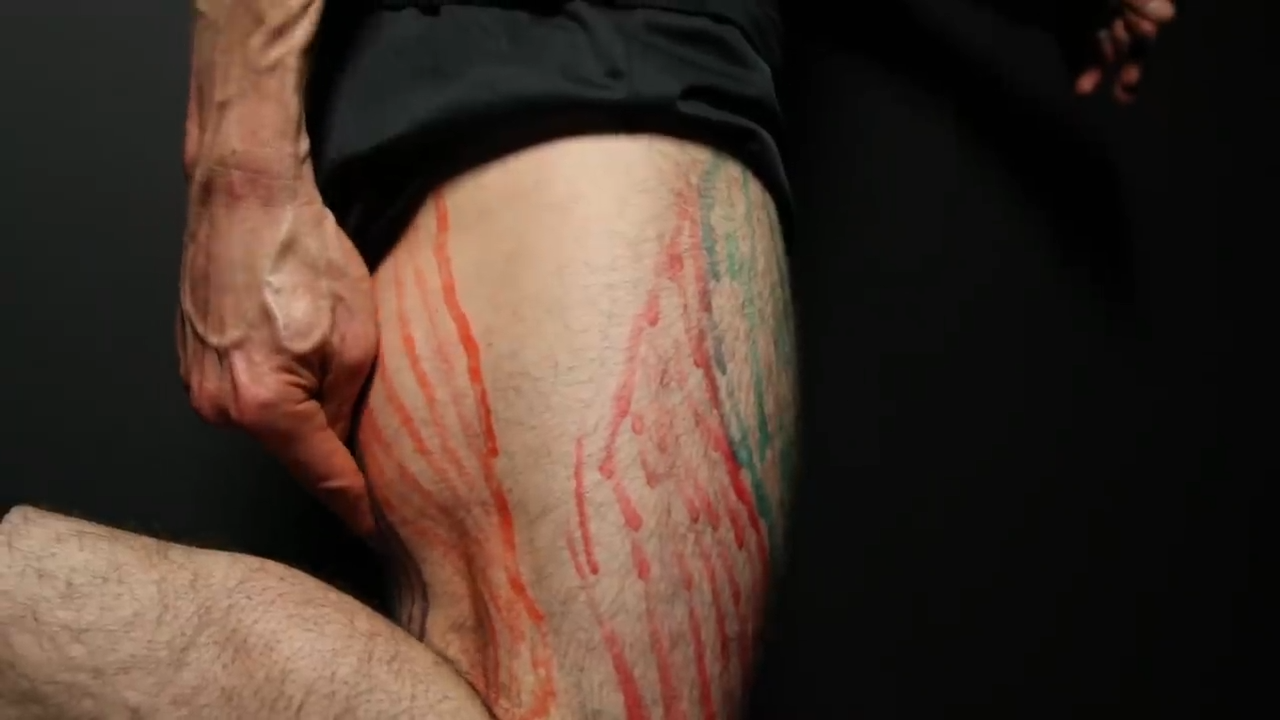
The Biceps Femoris is on the outside of the Hamstrings.
SEMITENDINOSUS

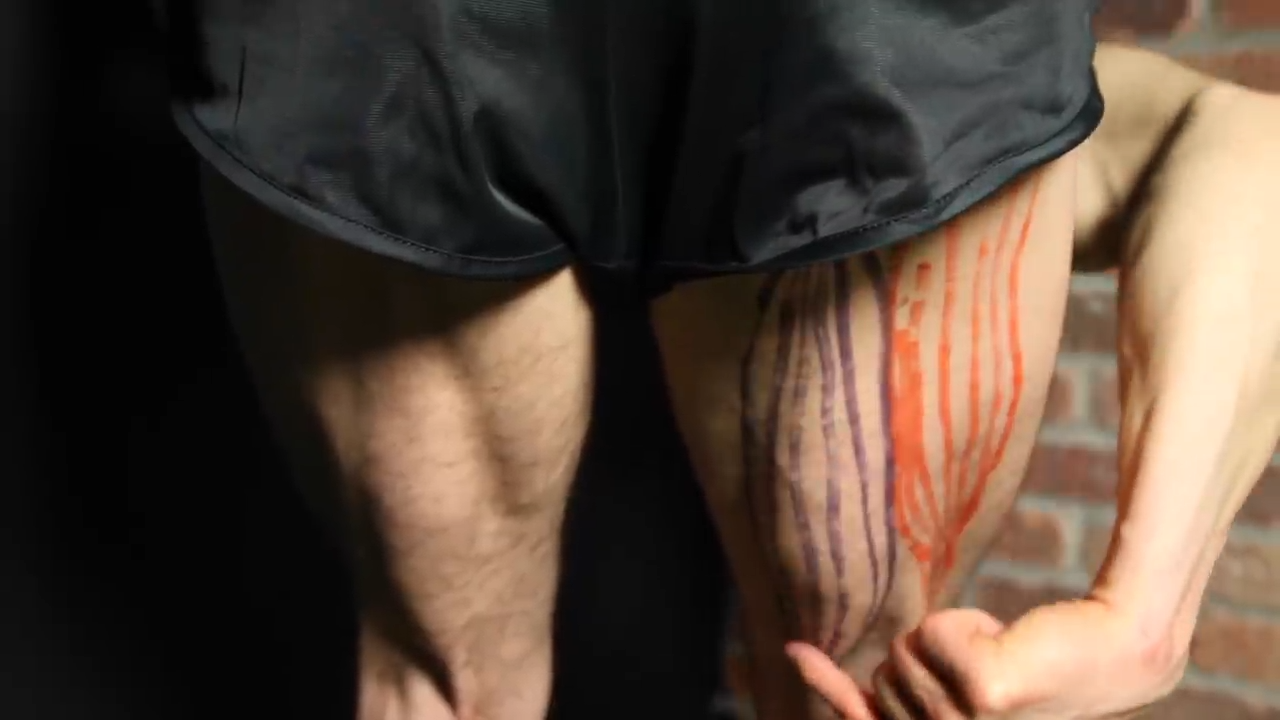
The Semitendinosus is on the inside of the Hamstrings.
THE ADDUCTORS
One of the most neglected yet important muscle groups is the adductors. You’ll find these muscles on the inside of the thighs.
ADDUCTORS

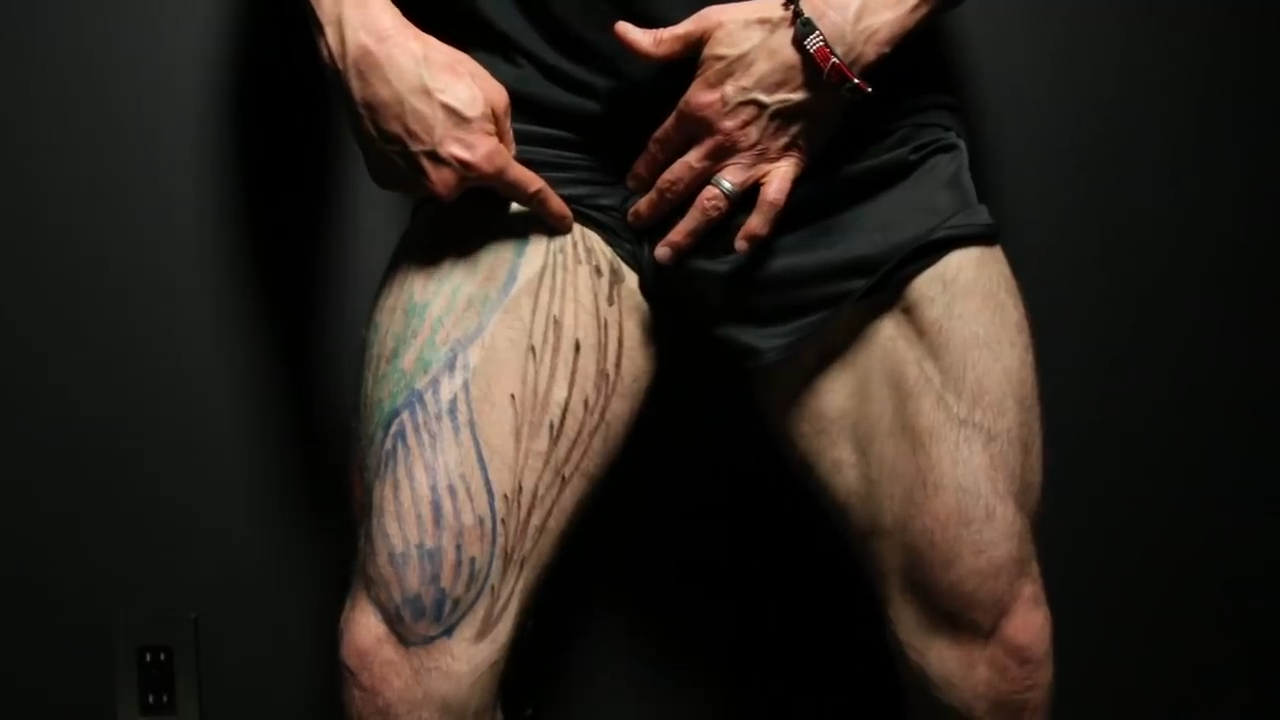
The Adductors are on the inside of the anterior chain and they help with rotation and flexion.
THE ABDUCTORS
The Abductors are a muscle group on the outside of your legs that require separate targeted training:
ABDUCTORS
The Abductors tend to be weak because most people neglect them, which is a big mistake because this all-too important muscle helps to move your legs outward while guaranteeing stability during single-leg exercises.
THE CALVES
Finally, we get to the bottom of the leg with the calves. There are two parts to the calf muscle: the Gastrocnemius and the Soleus.
GASTROCNEMIUS
The Gastrocnemius is the larger part of the calf, and the main part that most people associate with big calves.
But there’s a big catch here.
You need the soleus just as much if you want to build three-dimensional calves. I’ll explain more below.
The Gastrocnemius helps with leg flexion at the knee and plantar flexion at the foot.
SOLEUS
The soleus is behind the gastrocnemius. While the latter gets the fame as the big part of the calf, it’s thanks to the soleus.
The upper part of the soleus muscle fiber is behind the gastrocnemius. That means if you can increase the size of the soleus, this will push the gastroc outward.
The result?
Your entire calf will look larger and more developed.
2) WHY ARE LEG WORKOUTS IMPORTANT?
Legs are the base of support for every functional activity we do both inside and outside of leg workouts with weights.
Without a strong lower body, we’re at a huge disadvantage when it comes to most sports, leg workouts, and day-to-day physical endeavors.
Think about it – every time we jump, sprint, change directions, or lift something heavy off the ground, which muscle group is doing the majority of the work?
Your legs!
That’s why having strong legs is so important for everyone – athletes and gym-goers alike.
But let’s further that point, focusing on athletes and those training with a specific performance goal in mind.
Depending on the exercises and how you adjust the variables, training the legs can significantly improve athleticism including speed, agility, and explosivity.
These are all qualities that directly translate to better performance on the field, court or ice.
CAN LEG WORKOUTS MAKE YOU FASTER?
The simple answer is yes, but there’s a bit more to it than that.
Doing any old leg workout won’t make you significantly faster, but if the exercises and sets/reps are programmed correctly, you can see some serious improvements in your acceleration, speed, and explosiveness.
When you train your legs with things like Sprints or Plyometrics, you’re actually teaching your nervous system to fire more quickly and efficiently.
This translates into better neuromuscular coordination, which is a fancy way of saying that your brain and muscles are working together more efficiently.
In other words, when you train your legs properly, you’re essentially teaching your body how to move faster and stronger with more accuracy.
CAN LEG WORKOUTS INCREASE YOUR VERTICAL?
Continuing with the point above, leg workouts can increase your vertical jump.
This is because, as we just discussed, they improve neuromuscular connection and help those fast-twitch – power-based – muscle fibers fire quicker with greater efficiency.
Exercises for leg day that focus on building explosive power such as Weighted Jump Squats or using a Plyo Swing will directly transfer to your vertical jump.
These types of exercises train your muscles to produce the most force possible in the shortest amount of time, which is exactly what you need to do when jumping.
HOW MANY DAYS A WEEK SHOULD YOU WORK LEGS?
If you want to see all the benefits associated with leg workouts, how many days a week should you work your legs?
Do you have to spend hours in the gym every day?
No! But you do need to be consistent with your workouts and dedication.
At the very least, you need one day fully dedicated to leg training, but optimally, you’ll hit your legs twice per week.
3) WHAT IS THE BEST LEG WORKOUT?
What makes an amazing – not just a good – leg workout?
The best leg workout is going to do three important things:
- Target all the leg muscles
- Hit every function of the legs
- Work the legs through all three planes of motion
This includes hitting not just the larger leg muscles, but all the smaller leg muscles as well as the hips.
And the best way to create an effective leg workout is to introduce exercises based on exercise type – not just because it’s the featured exercise of the week on someone’s channel.
The type of exercise usually corresponds with its function, so we’ll knock out two birds with one stone.
There are six major types of leg exercises that I’m going to make sure we address. I’m also going to provide you with the optimal exercise for each type.
ANTERIOR CHAIN COMPOUND LIFTS
To kick off your leg workout, I want you to start with an effective exercise that allows you to use heavy weight.
I’m talking, of course, about the king of leg exercises: the Barbell Back Squat.
BARBELL SQUATS

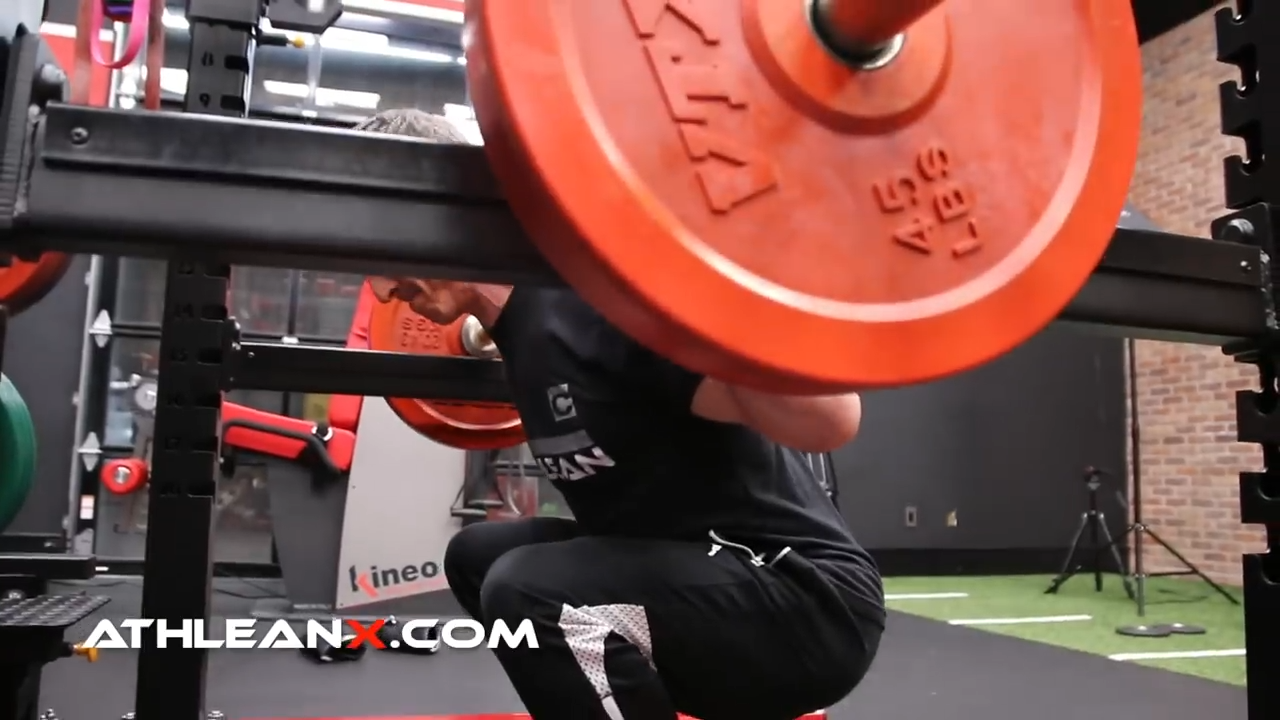
HOW TO DO BARBELL SQUATS:
- For this traditional squat exercise, starting position is with a loaded barbell and position your feet shoulder width apart.
- Grab the bar from the rack and place it upon your traps – not your neck.
- Begin slowly lowering your body through the entire range of motion until your thigh muscles are parallel or just beyond parallel to the floor.
- Contract the glutes to force yourself to stand up into an upright position. Use proper squat form throughout the entire movement to reduce risk of injury.
WHAT MAKES IT EFFECTIVE: The Barbell Squat is one of the foundational leg exercises for building muscle strength in the lower body muscles. It’s a classic for a reason: it works!
POSTERIOR CHAIN COMPOUND LIFTS
Next up, we’re going to target your posterior chain with a heavy compound exercise that achieves muscle activation in the hamstrings and glutes in one powerful movement.
Are you expecting a traditional deadlift or Romanian deadlift variation?
You might be surprised to know that deadlifts are not my pick among compound leg exercises for the posterior chain. Instead, I’m going with the Barbell Hip Thrust to build stronger glutes.
BARBELL HIP THRUST
If your main goal is building lower body strength and increases in muscle mass, the Barbell Hip Thrust is a compound exercise that allows you to use a heavier load. So, it’s perfect for strength and muscle growth.


HOW TO DO THE BARBELL HIP THRUST:
- Start in proper position with your feet about shoulder width apart. Lie with your upper body and feet flat on the floor. Bend your knees at a 90-degree angle. Place your shoulder and head on a workout bench, stable box or other elevated surface.
- Rest the barbell on your pelvis near your hip flexors. Adjust your hands so you have a grip at shoulder width or just outside of shoulder width.
- Contract your glutes and drive your hips up in a controlled movement. Squeeze through the hamstrings.
- Pause at the top and slowly lower yourself to the starting position. Take a few minutes of rest between sets of this compound movement.
WHAT MAKES IT EFFECTIVE: This helps you recruit your glutes to be the main driver of the movement, and then allow the hamstrings to assist. Many of us do not have good control over our glutes, so starting out with a lighter weight helps us to establish that mind muscle connection to the glutes.
LEG EXERCISES FOR SINGLE LEG TRAINING
Standard squats and deadlifts aren’t everything. The value of single-leg training cannot be overstated because they help work through any issues with balance of strength between one leg and the other.
Unilateral exercises such as the Walking Lunge or Regular Lunges and Split Squats provide dynamic stability benefits in the hips.
But they also challenge the frontal plane of the body in ways that traditional bilateral training such as weighted squats cannot do, allowing for additional muscle gains.
BULGARIAN SPLIT SQUAT IN HIGH-LOW FASHION
You might be familiar with the traditional Bulgarian Split Squat. But our version is a Split Squat variation called the Bulgarian Split Squat in High-Low Fashion.


HOW TO DO THE BULGARIAN SPLIT SQUAT:
- Starting position for this glute exercise is with your left foot on the floor, bending your knee of the left leg at a 90-degree angle.
- Rest your right leg on a workout bench behind you with dumbbells in each hand.
- With the upper body and torso upright, lower down until the dumbbells touch the floor and then come back up.
- Then on the next rep, you’ll go down into a Sprinter Lunge position, which means you’ll lean forward. This places a deep stretch and demand on the glute muscles.
- Alternate reps between the straight down position and the Sprinter Lunge position. Use your core strength for stability throughout the movement.
WHAT MAKES IT EFFECTIVE: This single-leg exercise can help you work through muscle imbalances since you are working just one side at a time.
LEG EXERCISES FOR EXPLOSIVITY
Explosivity is one type of leg exercise that rarely gets included. Guys, listen up: explosivity should be a part of all your leg training days.
For the best leg workout, I want to include the Bodyweight Plyo Bulgarian Split Squat exercise. Not only will this effective movement help you develop your explosive movement patterns, but you’ll also build strong glutes and legs.
BODYWEIGHT PLYO BULGARIAN SPLIT SQUATS


HOW TO DO THE BODYWEIGHT PLYO BULGARIAN SPLIT SQUAT:
- For this bodyweight exercise, starting position is with your left foot in front of you and the rear foot on a bench behind you. Jump explosively, pushing through the front leg.
- You don’t have to do this but if you want to add an extra challenge, go ahead and clap your hands under the back of the knee.
- Once you finish on one side, repeat the exercise on the other leg.
WHAT MAKES IT EFFECTIVE: You should always try to speed up what you slow down, and this functional fitness exercise does just that. This ensures you don’t get stuck with slow moving movement patterns. Also, the Bodyweight Plyo Bulgarian Split Squat helps us train for stability of the knee in jumping and landing.
LEG EXERCISES FOR THE INSIDE AREA OF THE QUAD
Let’s move away from the big shots of the legs, and talk about the area that gets very little attention – if any at all.
The inside of the quad is important for providing support and stabilization, especially during heavy lower body exercises.
Now, while you can’t isolate the medial or inner portion of the quads, you can influence its ability to contract fully and ensure it gets full stimulation.
And you can do this by going to a full lockout position of extension on every rep. My favorite way to do that is with the TKE Drop Lunge.
TKE DROP LUNGE

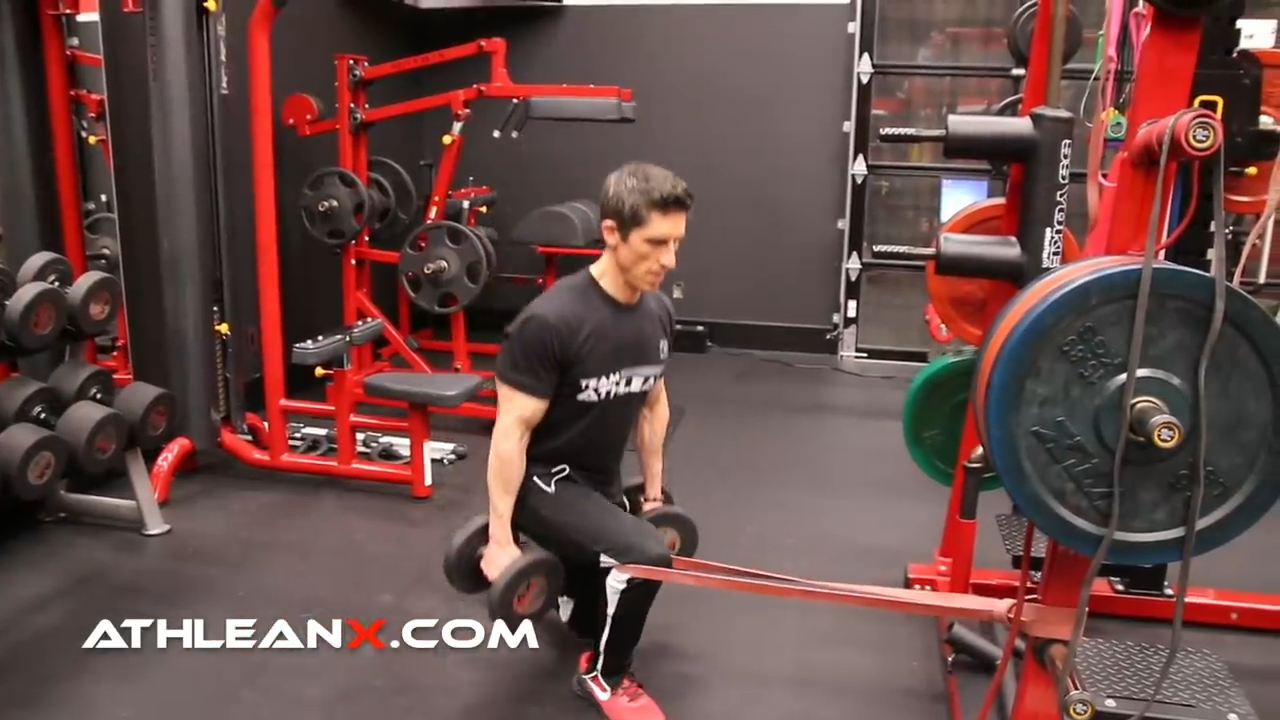
HOW TO DO THE TKE DROP LUNGE:
- Select dumbbells that feel appropriate to you, but remember that you can go with heavy loads for this one.
- Stand with your feet roughly shoulder width. Put the band behind your knee.
- As you go down for the lunge, the band will resist pulling your knee forward.
- When you come back up, drive your knee back as hard as possible, into full extension. Use your core strength for stability throughout the movement.
WHAT MAKES IT EFFECTIVE: This advanced exercise is a great way to ensure resistance through terminal knee extension. You can also overload this exercise with dumbbells with the addition of resistance bands as well.
LEG EXERCISES FOR ADDUCTORS
Continuing with the idea above, it’s time to give some additional attention to the adductors.
Many people believe that after hitting quads and hamstrings, your leg workout is over.
This is not the case – not even close!
Guys, all muscles matter, even the little ones we don’t think much about.
And to hit the adductors, we’re going to use one of my favorite dumbbell leg exercises, the Goblet Adductor Lunge.
DUMBBELL GOBLET ADDUCTOR LUNGE

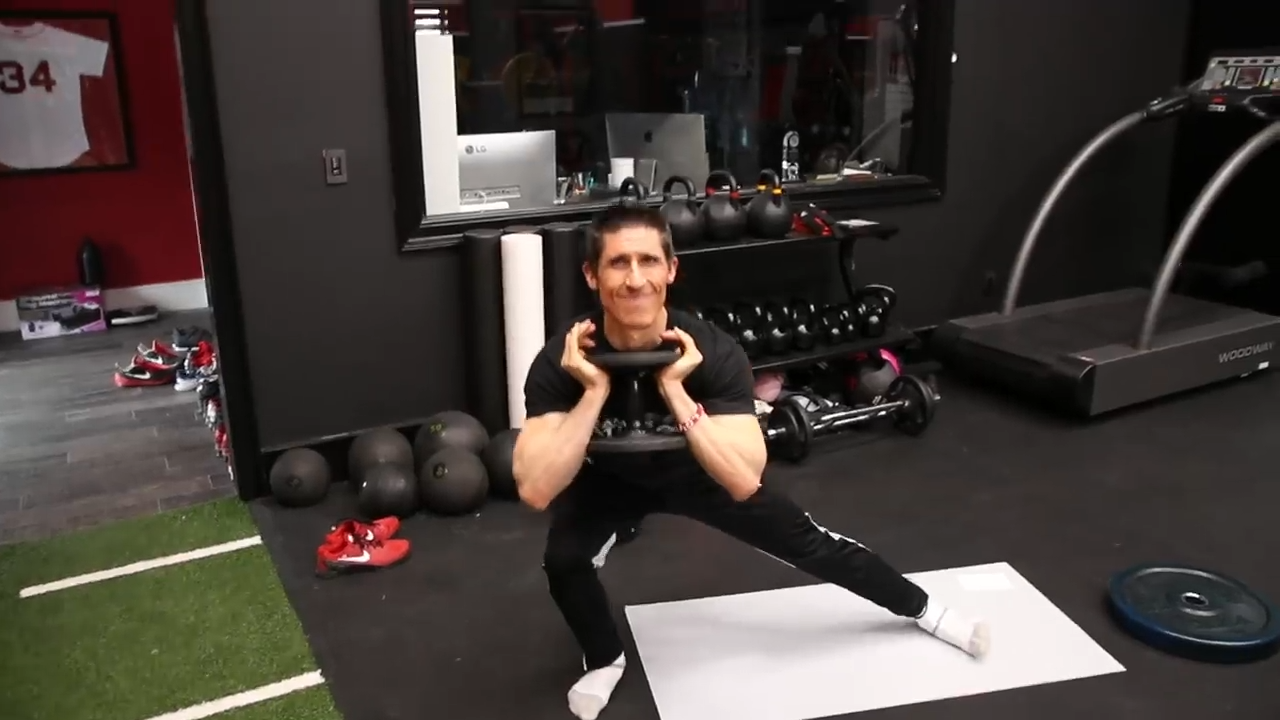
HOW TO DO THE DUMBBELL GOBLET ADDUCTOR LUNGE:
- You can do this on a hardwood or slick floor with your socks on. Hold a dumbbell in the traditional goblet stance.
- Perform a lateral lunge, sliding your left leg out.
- Squeeze your legs together to get yourself back to a standing position.
- Repeat on the other side once you finish with all of the reps. Keep your core tight throughout the movement.
WHAT MAKES IT EFFECTIVE: This is going to activate the important adductor muscle fibres on the inside of your thighs, which will help you build inner thigh strength.
LEG EXERCISES FOR ABDUCTORS
Last but not least, we move to the opposite side of the adductors with the abductors, which are on the outside of the hips.
The best way to target the abductors is with a Hip Band Ladder finisher.
What this awesome exercise lacks in resistance, it makes up for with a lot of burning.
HIP BAND LADDER

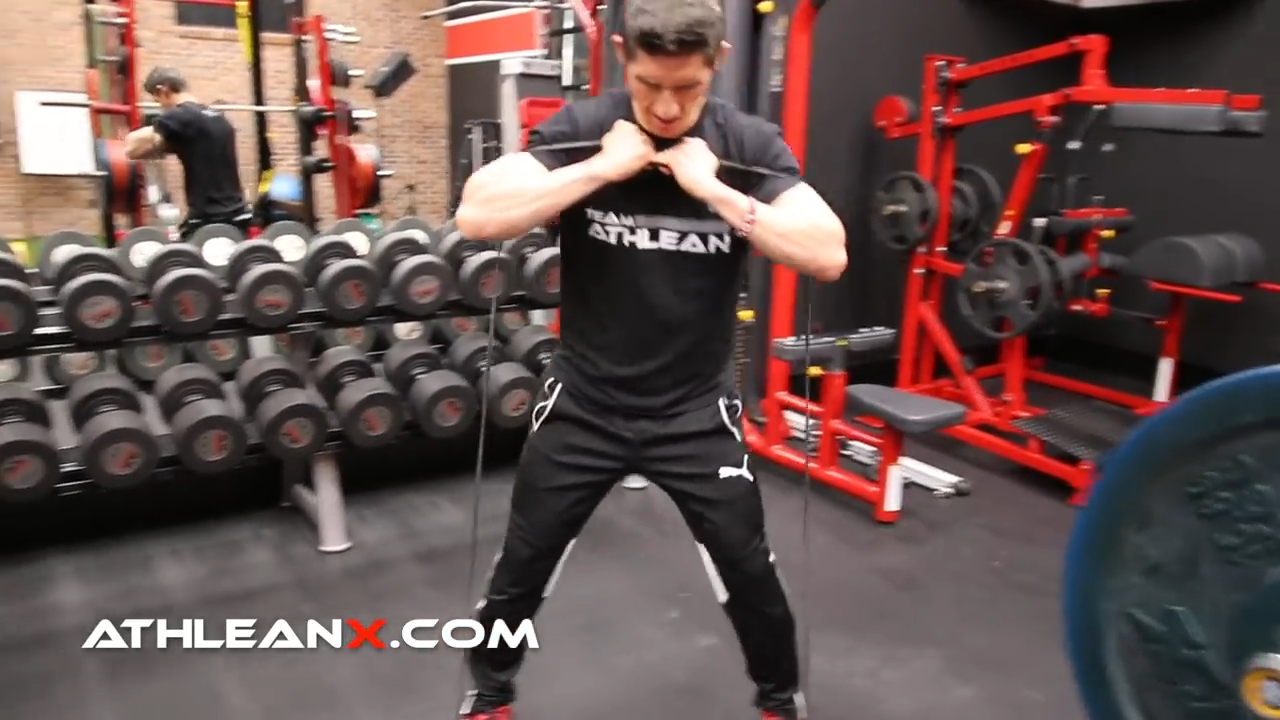
HOW TO DO THE HIP BAND LADDER:
- Wrap a band from your feet to your shoulder and hold it across your chest. Maintain a slight bend in the knees.
- Start with one step to the right and one step back to the left.
- Then move two steps out to the right and two steps back to the left.
- Work your way up the ladder until you reach 10 steps in each direction. Get ready to burn!
WHAT MAKES IT EFFECTIVE: The abductors are chronically weak, and this exercise directly targets them, forcing them to work overtime.
To see more of the best legs exercises that hit these muscles and how to incorporate them into your legs training programs, check out the article Best Leg Workout.
4) WHAT ARE THE BEST LEG EXERCISES FOR KNEES?
At this point, some of you are looking at these exercises that I’ve covered, and you might be getting concerned about your knee pain.
Do you get knee pain when you train legs? If so, this whole section is for you. If you are using the wrong exercises with bad knees, then leg workouts can be trouble.
That doesn’t mean you should be skipping leg day!
You shouldn’t lose your leg strength and muscle definition. Instead, you can learn to train smart – avoiding knee discomfort while improving your leg muscles.
“Wait a minute, Jeff. You’re an athlete and a physical therapist. It’s easy for you to say this.”
Guys, remember that having an athletic background, I pretty much trashed my knees back in 1993. The truth is that they never really recovered!
What did I do? I changed the way I train so that I could focus on building strong legs and protecting my knees from further damage.
And you can learn to do the same thing with these exercises for knee issues.
Just a quick breakdown of what to expect:
The following leg movements are closed chain and functional with a high degree of athletic carryover.
The reason I picked these exercises is because there is a heavy focus on keeping the force shifting down and back as opposed to down and forward.
This ensures the knee joint doesn’t take on unnecessary strain and extra stress.
Give these exercises a try and you’ll see that it is possible to train legs with minimal knee pain and without risking further knee damage.
So, what are the best leg workouts for knees?
BEST QUADS EXERCISES FOR KNEE PROBLEMS
Let’s start this effective leg workout for knee pain with some squats, but not just any squats.
I’ll use some isometric and pause techniques to help minimize the impact on the knee joint.
For your quad-focused workout, I’ve chosen the Isometric Squat Hold.
But one important thing to note: Whether you choose an isometric or pause variation of the squat, there is one important key with these squats.
You must be in control of every rep.
This means you’ll need to start with either body weight only or light weight. Eventually, you can begin to add additional weight once you have complete control over the load you are squatting. Starting with the heaviest loads will only set you up for injury.
ISOMETRIC SQUAT HOLD

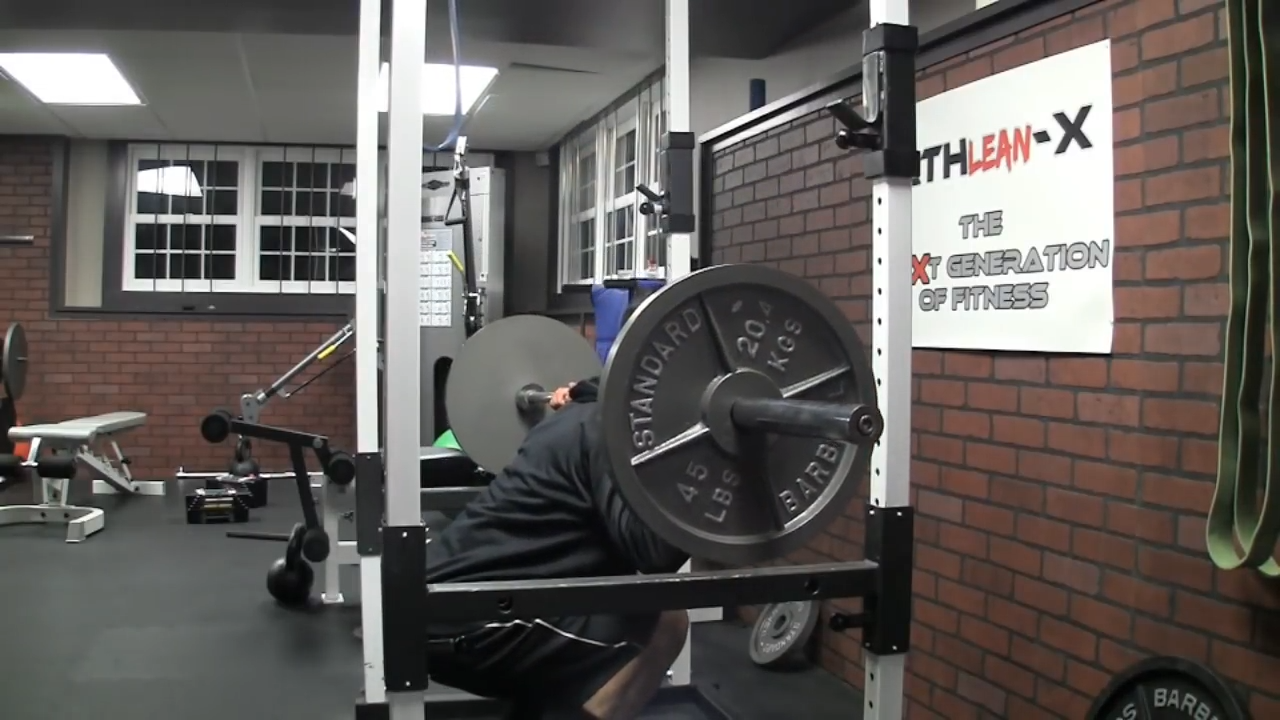
HOW TO DO THE ISOMETRIC SQUAT HOLD:
- Be sure your starting position is with feet flat on the floor. Your toes shouldn’t be lifting off the ground as you lower. Step up to the squat rack and position the bar along your traps.
- Kick your hips back and keep your chest up as you lower yourself down.
- Come to parallel – or just below parallel if it feels okay. Your goal here is to hold this for about 20 seconds. This will ensure you have good stability and a strong foundation.
- Add weight at your discretion but play it safe and add the minimal effective dose.
WHAT MAKES IT EFFECTIVE: The Isometric Squat Hold done with a lighter weight helps to build stability and determine the status of our knees before we begin adding weight.
PAUSE SQUAT
It’s important that you start with the Isometric Hold Squat because this will help you determine what you’re able to handle with a Pause Squat, which is the next progression.

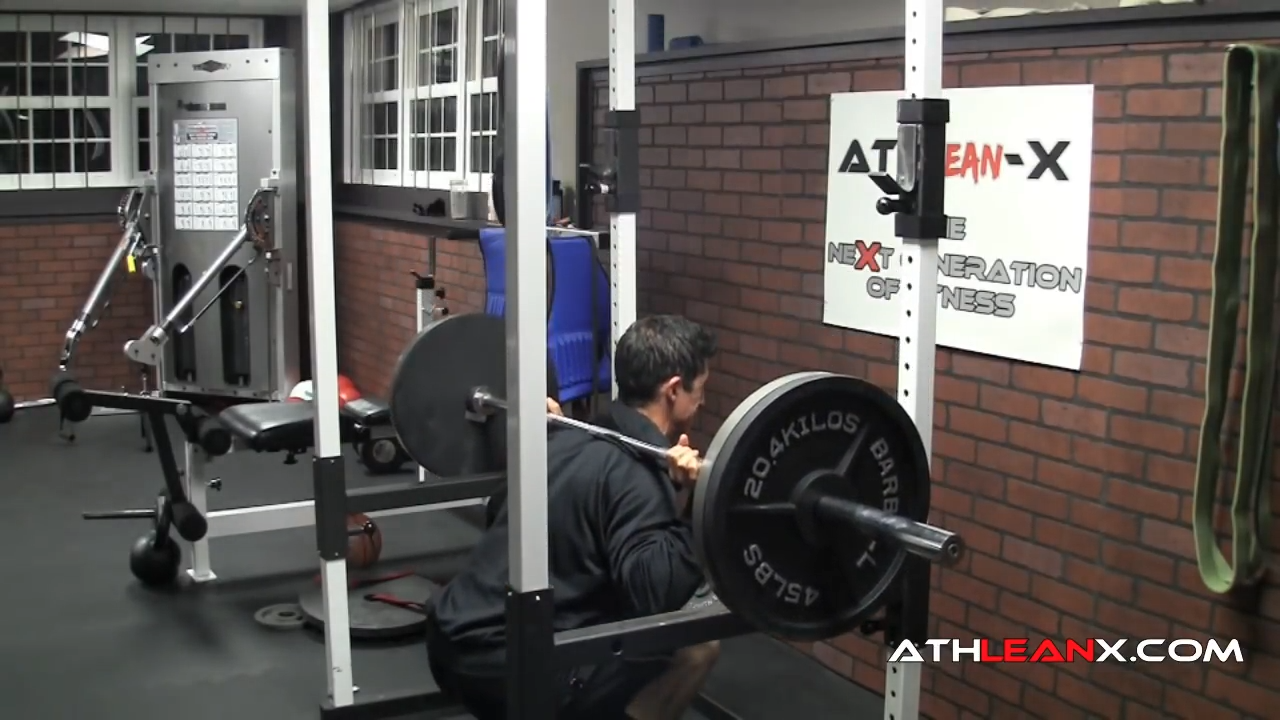
HOW TO DO THE PAUSE SQUAT:
- Before you begin, step to the sides of the squat rack and increase the weight load that you’re using. It doesn’t have to be a dramatic change. Focus on a weight plate that’s manageable – something you can control when pausing for a few seconds as opposed to 20 seconds.
- Take the same form as the Isometric Hold Squat, pause at the bottom but only hold it for a few seconds before coming up.
- During all of your sets, you need to make sure that your legs and knees always feel good. Just as important, make sure that you’re always in control of the exercise. Take a rest interval of 1-2 minutes between sets of this movement.
WHAT MAKES IT EFFECTIVE: Pause Squats allow you to push heavier weight while creating stability and strength in the quads.
PAUSE SQUAT W/ADDITIONAL LOAD
If you’ve performed the Isometric Hold Squat and Pause Squat without any issues, you can graduate to the Pause Squat with Additional Load.
Increase the weight again but only if you can and feel comfortable doing so.
Remember: You want to make sure your legs and knees feel alright and that you feel in control of the weight the ENTIRE time.

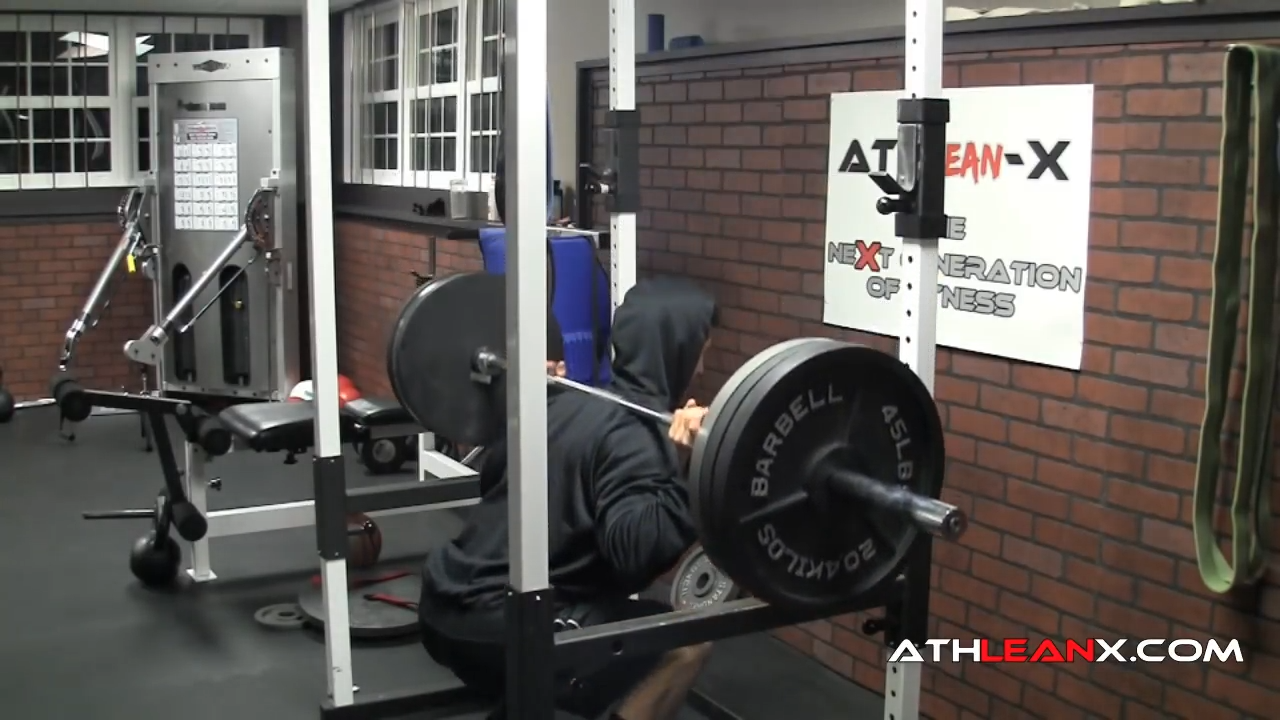
HOW TO DO THE PAUSE SQUAT W/ADDITIONAL LOAD:
- Follow the same form as the Pause Squat but add some extra weight. Again, don’t overdo it.
WHAT MAKES IT EFFECTIVE: Pause Squats allow you to push heavier weight while creating stability and strength in the quads.
REVERSE LUNGE
Now I’m going to talk about one of my all-time favorite exercises for legs, the Reverse Lunge.
Knee pain is one of the most common issues people have when doing lunges.
What most people don’t realize is that not all Lunges are created equal. The direction of the Lunge makes a HUGE difference.
You might not realize it, but Forward and Reverse Lunges work the knee and hip in different ways.
Forward Lunges are “open chain.” This means the foot is not in contact with the floor. And when the foot lands, ground forces travel up through the knee. This can cause knee pain.
Reverse Lunges, on the other hand, are “closed chain.” In other words, the foot stays in contact with the ground so there’s no impact force.
Also, I’ve opted for Reverse Lunges because you can go pretty heavy without the knee injury repercussions associated with traditional Front Lunges.

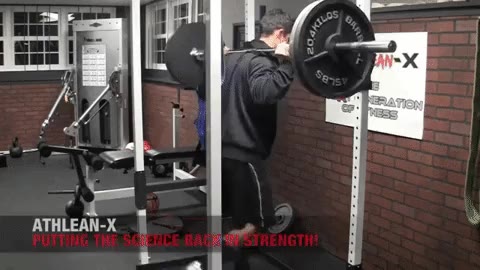
HOW TO DO THE REVERSE LUNGE:
- You can use dumbbells here, but I prefer to do this with a barbell because I don’t have to worry about my grip giving out as I’m moving the heavier weights.
- Start with your feet hip width apart, then bring your left foot back behind you, lowering down until your left knee almost touches the ground. Keep your upper body upright.
- Push up, maintaining strong core muscles and then repeat on the right leg.
WHAT MAKES IT EFFECTIVE: The Reverse Lunge allows you to go heavy to build and strengthen your quads without worrying about the high-impact nature of Front Lunges, helping you to avoid risk of injury.
DUMBBELL BULGARIAN SPLIT SQUAT HOP
From here, we move on to the Dumbbell Bulgarian Split Squat Hop.
The slight hop during the split squat adds an additional acceleration component.
You might hear “hop” and get worried but with this split squat position, the weight is traveling down and back so you shouldn’t feel any knee joint pain.

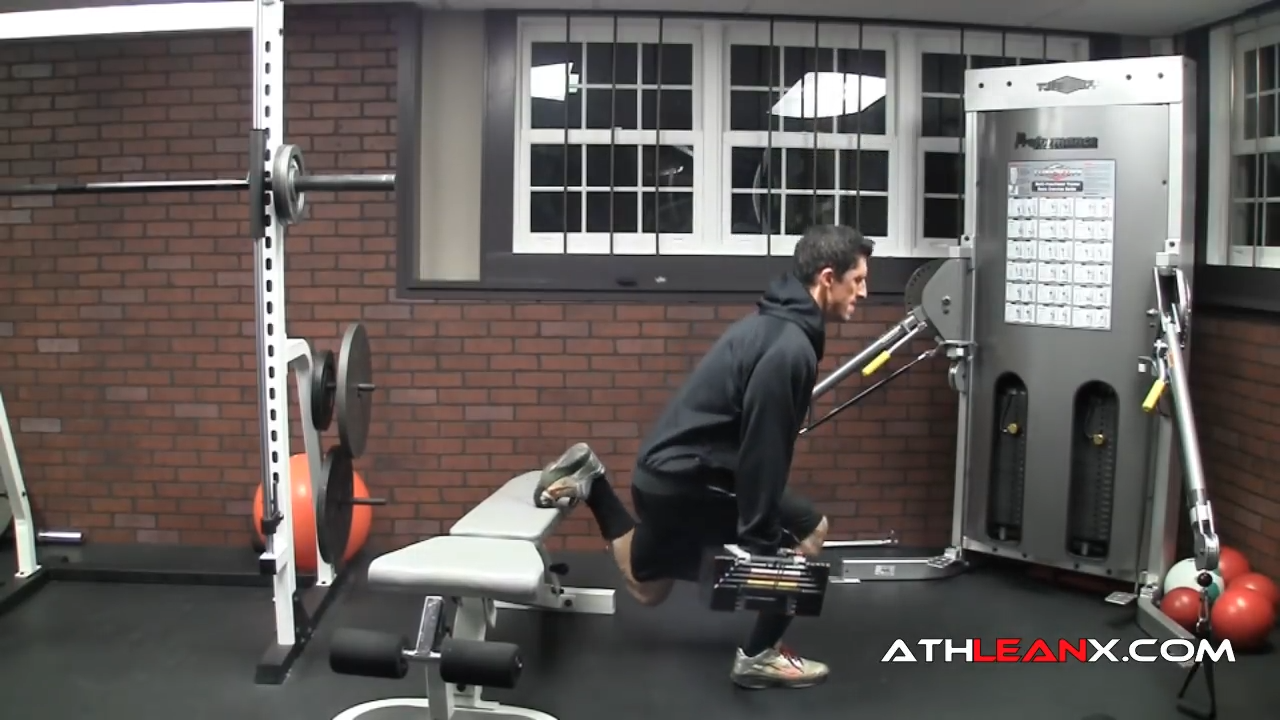
HOW TO DO THE DUMBBELL BULGARIAN SPLIT SQUAT HOP:
- Grab a set of dumbbells in each hand and start with your feet hip width apart, then bring your left foot back behind you.
- Lower down until your left knee almost touches the ground. Keep your upper body upright.
- Push up with a slight jump at the top of the movement, maintaining strong core muscles and then repeat on the right leg.
WHAT MAKES IT EFFECTIVE: Pairing this with the dumbbell version, you’ll be able to reach true muscle failure without stressing the knee.
BEST HAMSTRINGS EXERCISES FOR KNEE PROBLEMS
Moving to the target muscles in the back side of the legs, we’ll take the same approach as the quads by focusing on closed-chain exercises to save your knees from stress.
For my knee-friendly hamstring exercises, I’ve got two of my favorite closed-chain alternatives to the typical open-chain machine-based hamstring exercises. These will help you get hamstring muscle activity without injury.
PHYSIOBALL GLUTE HAM RAISE
The Physioball Glute Ham Raise is one of the best closed-chain options for overloading the hams and the gluteal muscles without hurting the knees.

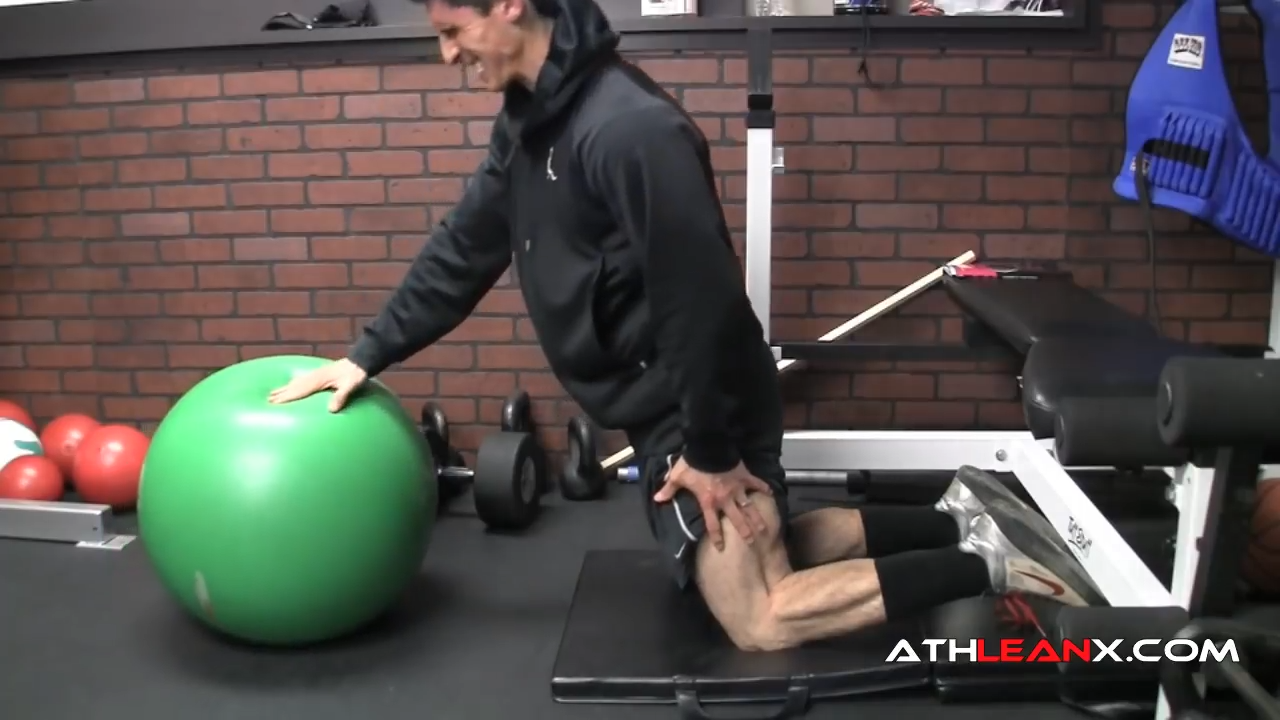
HOW TO DO THE PHYSIOBALL GLUTE HAM RAISE:
- Start by kneeling on the floor with your knees at hip-width apart. Place the tops of your feet on the floor. Place one hand on a physioball in front of you.
- Begin to lower your upper body toward the floor as much as your range of motion will allow you to.
- Keep your body in a straight line from your head to your knees.
WHAT MAKES IT EFFECTIVE: This exercise allows you to move yourself out and extend into eccentric hamstring overload, using the ball as a kind of spotter. Just in case you go too far forward, the ball has your back.
BARBELL HIP THRUST
We’ll wrap up the knee-friendly leg exercises with my favorite barbell hamstring exercise: the Barbell Hip Thrust.

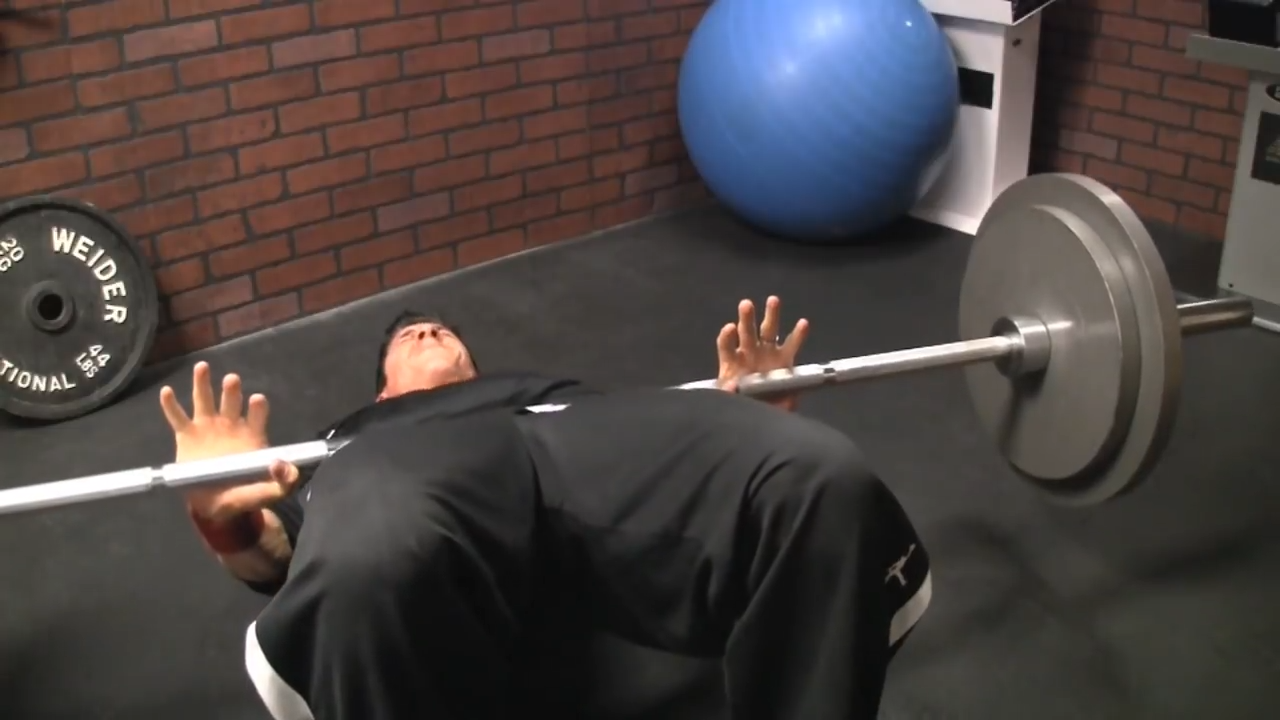
HOW TO DO THE BARBELL HIP THRUST:
- Place a padded barbell across your pelvis. Start with your feet shoulder width apart on the floor.
- Be sure to keep them in contact with the floor as you lift the barbell, focusing the contraction in your posterior chain muscles (hamstrings and gluteus maximus).
- Remember to push the bar forward on your hips so it doesn’t roll back towards you.
WHAT MAKES IT EFFECTIVE: Another great closed-chain exercise, the Barbell Hip Thrust allows you to build strength in the hamstrings without putting stress on the knee joint.
If you’re looking for more safe leg exercises for knees, you can check out my article Killer Leg Workout for Sore Knees.
5) WHAT ARE THE BEST EXERCISES FOR CALVES?
When it comes to your calves, what’s the one thing that everyone talks about? Genetics.
Talk to enough people and you’ll start to believe that you’re one of two people: a CALF or a CALF-NOT.
Admittedly, this is partially true but it’s only half the story.
While genetics do play a large role in calf muscle size, there are some great calf exercises to get them to grow.
You don’t have to live with small stubborn calves forever!
Here’s an excellent exercise that, when done consistently and correctly, can get bigger calves and stronger calves in no time.
CALF LAUNCHERS

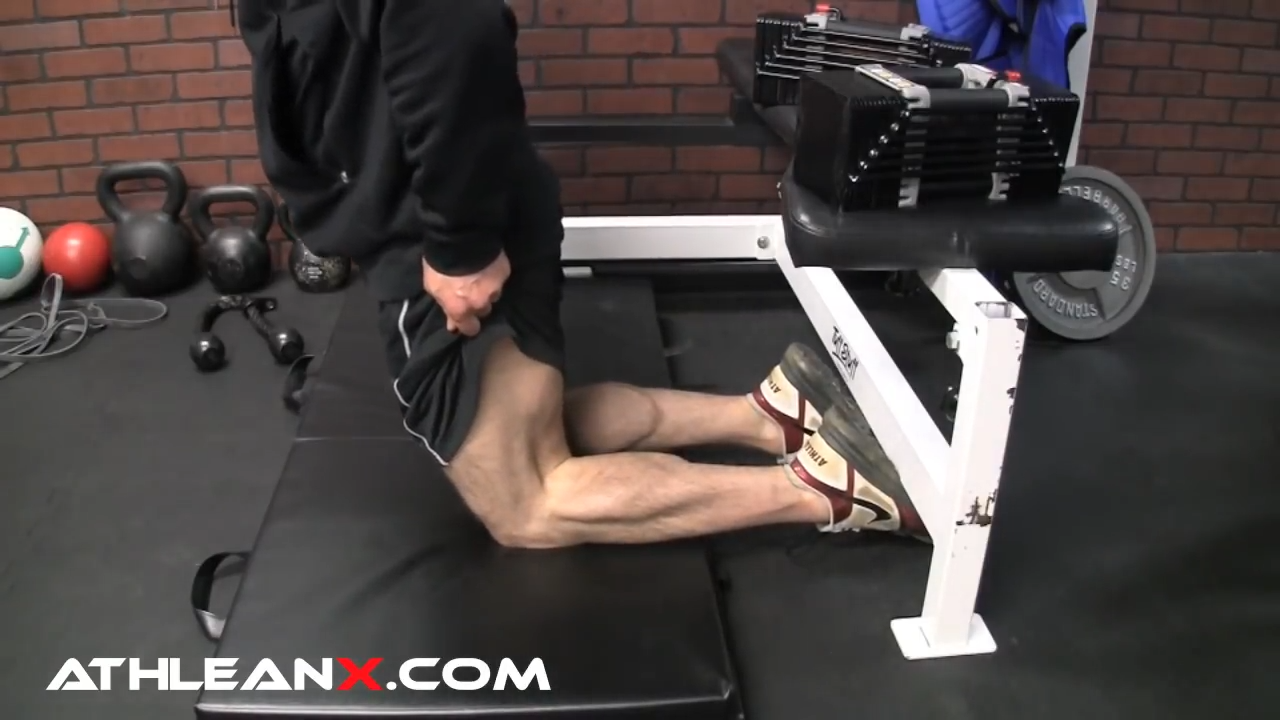
HOW TO DO CALF LAUNCHERS:
- Start by anchoring your feet under a bench or couch. Kneel on a mat or on the floor with your feet hip-width apart and your ankles flexed backward.
- With your feet secured, lift your heel and flex your feet in order to keep your body upright. You will feel the calf contraction immediately.
- Slowly launch your body out, leaning forward with the core engaged throughout the entire exercise.
- Use only as much range as you need to feel the calf muscles kick in. Perform a curl motion to get yourself back up and start again.
WHAT MAKES IT EFFECTIVE: Think of this resistance exercise like a curl for your legs. This isolation movement is guaranteed to provide a strong contraction in the calves, forcing them to work and not allowing for any muscle or tendon compensation.
6) HOW TO GET BIGGER LEGS
Would you believe it if I told you I used to be what you’d call a “hardgainer” when I was younger?
I’m not kidding when I say that I struggled to gain even a little bit of muscle mass.
Thankfully, I learned how to work my way out of the hardgainer status and you can too!
The most stubborn part of my body as a hardgainer?
My legs…
It’s possible to grow tree trunk legs, and I have four tips that will instantly transform how you go about your leg workouts.
KEEP YOUR EGO IN CHECK WHEN YOU SQUAT
It can be a bit intimidating to watch others squat several plates as you put a single 25-pound or 45-pound plate on each side of the bar.
Don’t let your ego take the wheel in your squat training program.
If you want to build bigger legs, the first thing you’re going to have to do is realize that you need to meet yourself at your level – not someone else’s level.
If all you can squat is a 25-pound plate on each side, that’s okay!
But you also have to make sure that you squat ALL THE WAY, no matter how much weight you’re squatting.
In other words, go through a full range of motion.
I’ve seen too many guys load up a bar and perform quarter squats like that will cure them of their small legs.
Not going to happen!
If you’re going too heavy AND not moving through a full range of motion on your squats, you’re not going to be able to build strength and mass in your legs.
Use a lighter weight and focus on achieving that intensity from the high rep sets that you do with good form through full range of motion.

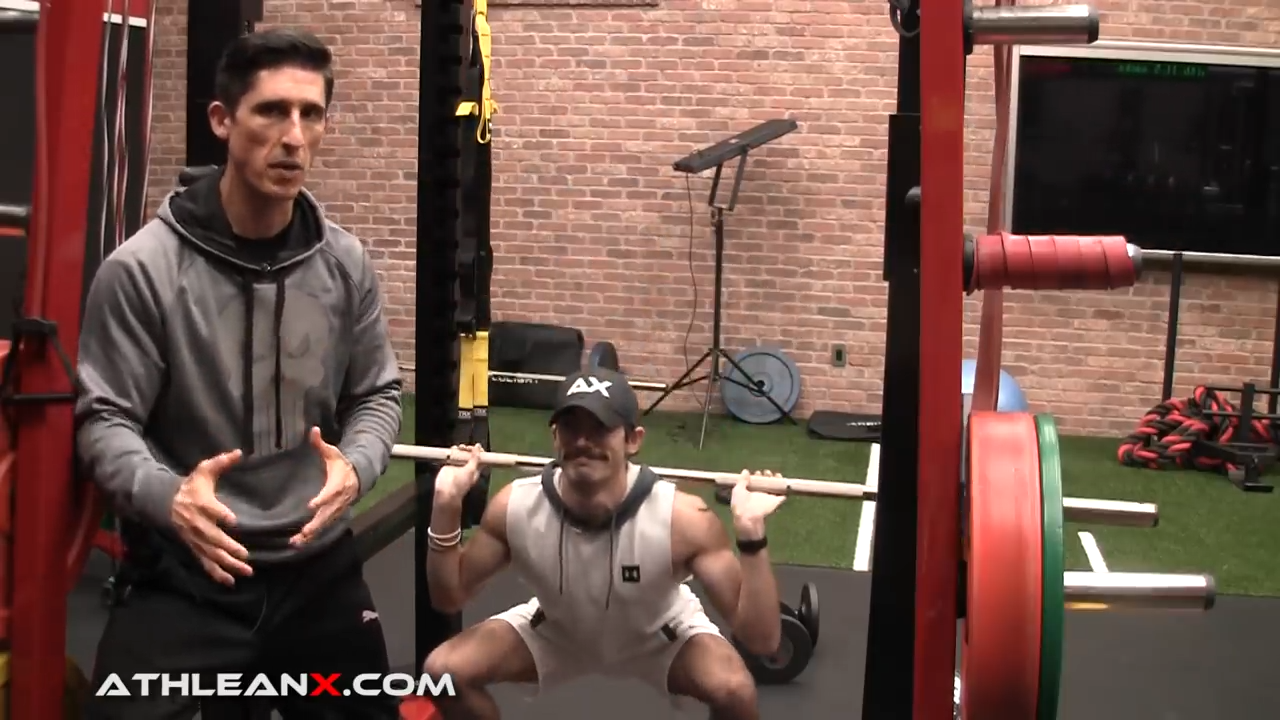
Continuing with the idea above, if you really want to take that intensity to a new level, try doing some Pause Squats.
In fact, take the numbers all the way up to 20 repetitions using a lighter weight.
It’s okay if you have to rest-pause at the top of the squat.
The goal is to have the intensity of the set in the higher rep range with a light load being the stimulus for growth.
At the same time, you can work on building up proper form, and then progressively add more weight to the end of the bar.
LEARN TO PUSH THROUGH YOUR FEET AS YOU DEADLIFT
A crucial skill you need to learn is how to push from the ground, and the best exercise to learn this with is the deadlift.
“But Jeff, isn’t the deadlift a ‘pulling’ exercise?”
Yes! But, there is a phase of a deadlift – right in the beginning – where you need to push with your feet to get the exercise started.
Learning how to push more will translate over to the squat and other leg exercises!
Think about it.
If you can’t exert force into the ground during a squat, how are you going to push up with all that force that’s coming down on your shoulders?
With the deadlift, we actually use our feet to drive through that first half of the range of motion.
In fact, you can think of the first half of the deadlift as a vertical leg press.

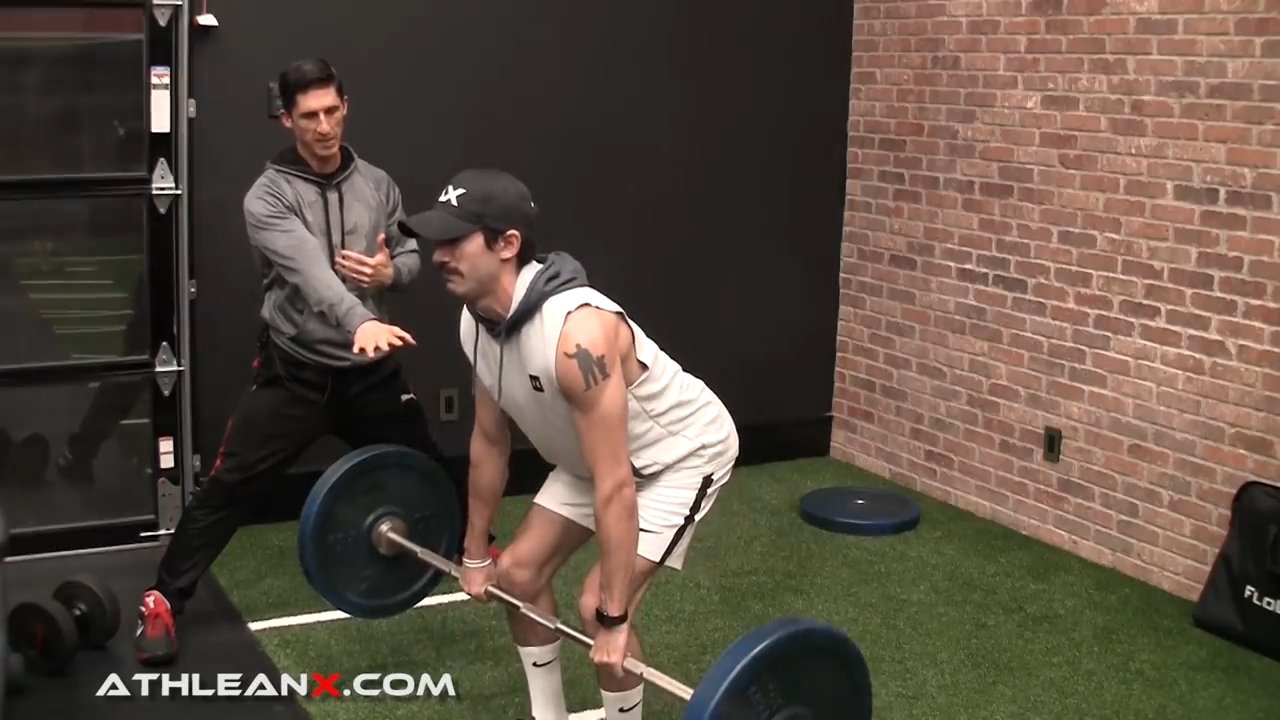
Instead of thinking about the deadlift as a pull exercise, think about it as a push exercise to the level of the knee, and then at that point we pull through the rest of the rep.
I want you to practice really pushing through the first half of the deadlift.
You’ll build more strength through the legs off the floor, and this will help you to dramatically increase your squat and ability to lift heavier weights over time.
Don’t worry about using a reverse grip or a mixed grip to help with your pulling. For now, focus on this part of the movement.
TRAIN IN ALL PLANES OF MOTION WHEN YOU LUNGE
When guys get too focused on breaking out of that hardgainer status, they tend to focus on just one plane of motion: the sagittal plane.
Think about all your favorite leg exercises: Squats, Lunges, Leg Extensions… They are ALL in the sagittal plane.
Doing only sagittal plane exercises doesn’t replicate the functionality of the legs and limits the muscle gain we could see if we also trained the adductors and abductors on the inside and outside of the legs.
The cure for your obsession with the sagittal plane? The Three-Dimensional Lunge.

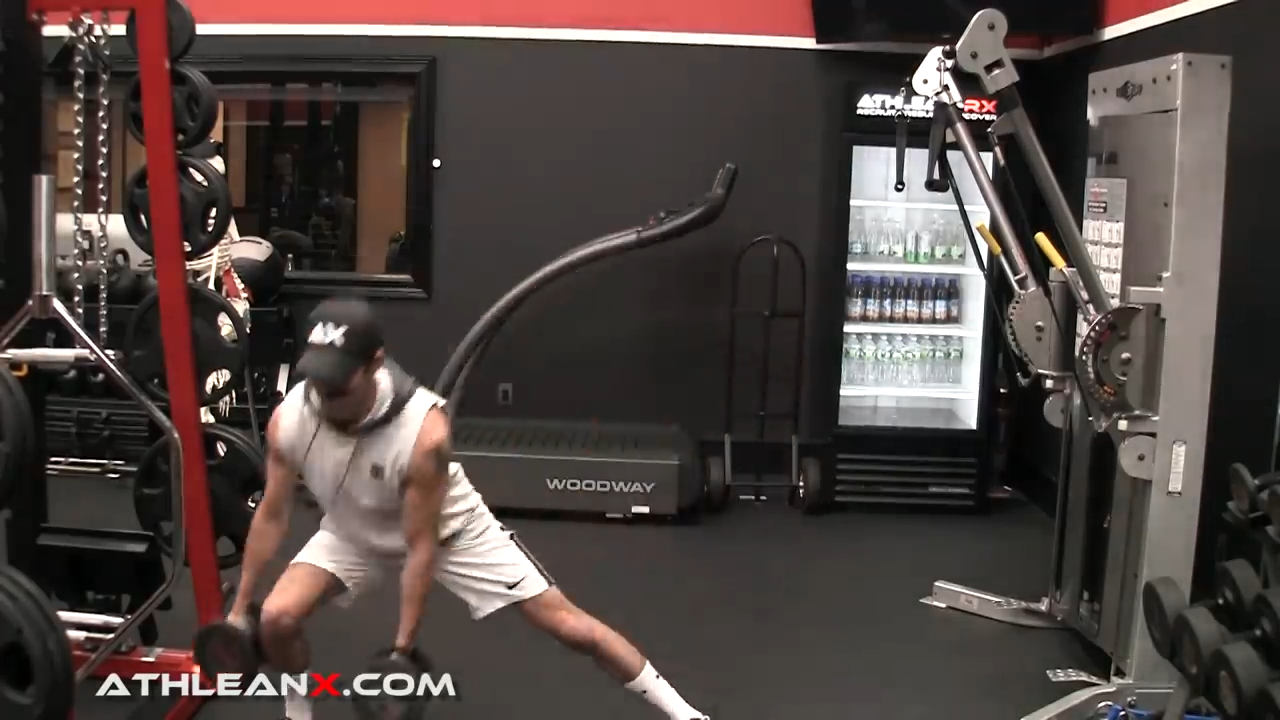
HOW TO DO THE THREE-DIMENSIONAL LUNGE:
- First, lunge forward to hit that sagittal plane.
- Then immediately go into a side lunge, which is in the frontal plane.
- Then follow it with a drop step lunge which is in the transverse plane.
- Then continue to repeat that sequence.
WHAT MAKES IT EFFECTIVE: The three-dimensional lunge allows us to work our legs in all three planes and get the adductors and abductors involved in our leg workouts.
LOAD SAFELY DURING A BULGARIAN SPLIT SQUAT
The Bulgarian Split Squat is one of my favorite exercises because it is easy to perform and allows you to add weight faster.
Split squats may seem like a technically more challenging exercise compared to the squat, but it really isn’t.
The exercise sets you up and keeps you in the right position from the start. So long as you stay in upright position, you’ll easily be able to overload the quad muscles.
If you aren’t able to continue with the weights you have, you can easily drop them to the side then continue to rep out using your body weight. Talk about an intense failure set!


HOW TO DO THE BULGARIAN SPLIT SQUAT:
- Start with your left foot on the floor, bending your knee of the left leg.
- Rest your right foot on a bench behind you with dumbbells in each hand.
- With the upper body staying straight up, lower down until the dumbbells touch the floor and then come back up.
- Repeat on the other side.
WHAT MAKES IT EFFECTIVE: Super easy to keep good form and overload the quads throughout. You can also safely ditch the dumbbells if you need to then use your bodyweight by training to muscle failure.
If you want more information on how to build bigger legs, check out my article Leg Workout Tips for Mass.
7) WHAT IS THE BEST DUMBBELL LEGS WORKOUT?
If you’re used to only using barbells in your leg workouts, you might wonder how to do leg exercises with dumbbells.
Leg workouts with dumbbells offer the advantage of safety with efficiency for some of the best exercises for overloading your legs.
I think the best way to break down my choices for the best dumbbell legs workout is by the goal that you’re trying to achieve.
Whether you want to bulletproof your legs, gain some size, or get stronger, this breakdown will let you pair up the exercises with your specific goal.
HYPERTROPHY: BULGARIAN SPLIT SQUAT
I’ve talked about this one already but it’s one of the best leg exercises, especially if you’re trying to see those legs grow.

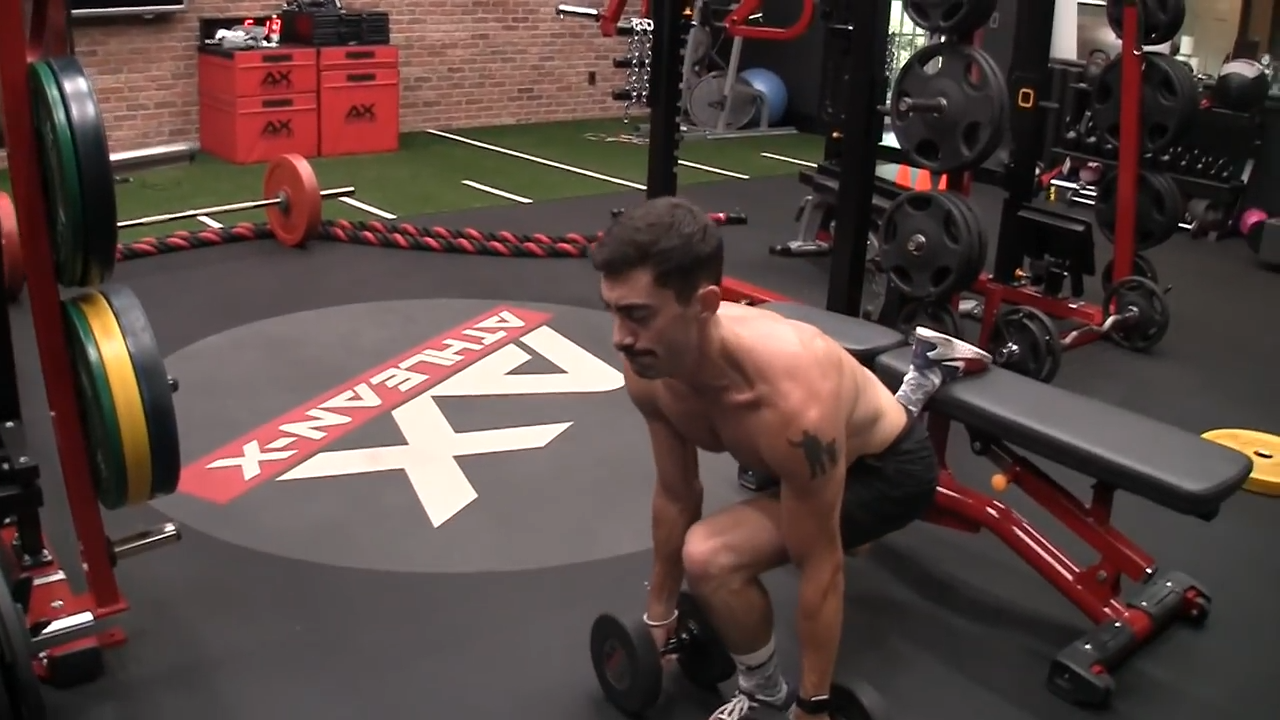
HOW TO DO THE BULGARIAN SPLILT SQUAT:
- Start with the left leg on the floor and the right leg positioned behind you on the bench and a dumbbell in each hand with an overhand grip.
- Lower your body and the dumbbells toward the floor, maintaining an upright torso, and repeat. The upright torso helps emphasize the quads in this movement.
- After completing all the reps on this side, switch sides with the right leg on the floor and the left leg positioned behind you.
WHAT MAKES IT EFFECTIVE: The Bulgarian Split Squat allows you to safely overload the quads without the risks that are present with a Barbell Back Squat. It also works your stability, mobility, and balance while improving neuromuscular efficiency.
POWER: DUMBBELL JUMP SQUAT
If you want to increase your explosive leg power, the Dumbbell Jump Squat is the way to do it
The Jump Squat alone is a terrific option for explosive leg workouts.
But when you add weight to it, you’ll see the benefits transfer over to other explosive exercises like the Hang-Clean and Power-Clean.


HOW TO DO THE DUMBBELL JUMP SQUAT:
- Choose a weight that’s between 25% to 50% of your bodyweight. If you go too heavy, you can slow down your ability to perform this properly.
- Here’s the starting position: Hold a dumbbell in each hand, then bend your knees and kick your hips back.
- Do not pause at the bottom of the squat. Jump explosively upward from squat position.
WHAT MAKES IT EFFECTIVE: This one exercise focuses on triple extension through the ankles, knees, and hips, allowing the kinetic chain to pass that power from the ground up into the explosive jump.
METABOLIC: WALK THE BOX
If your aim is to increase metabolic efficiency in your legs, then I have the perfect exercise for you. Walk the Box is notoriously intense, but it delivers!

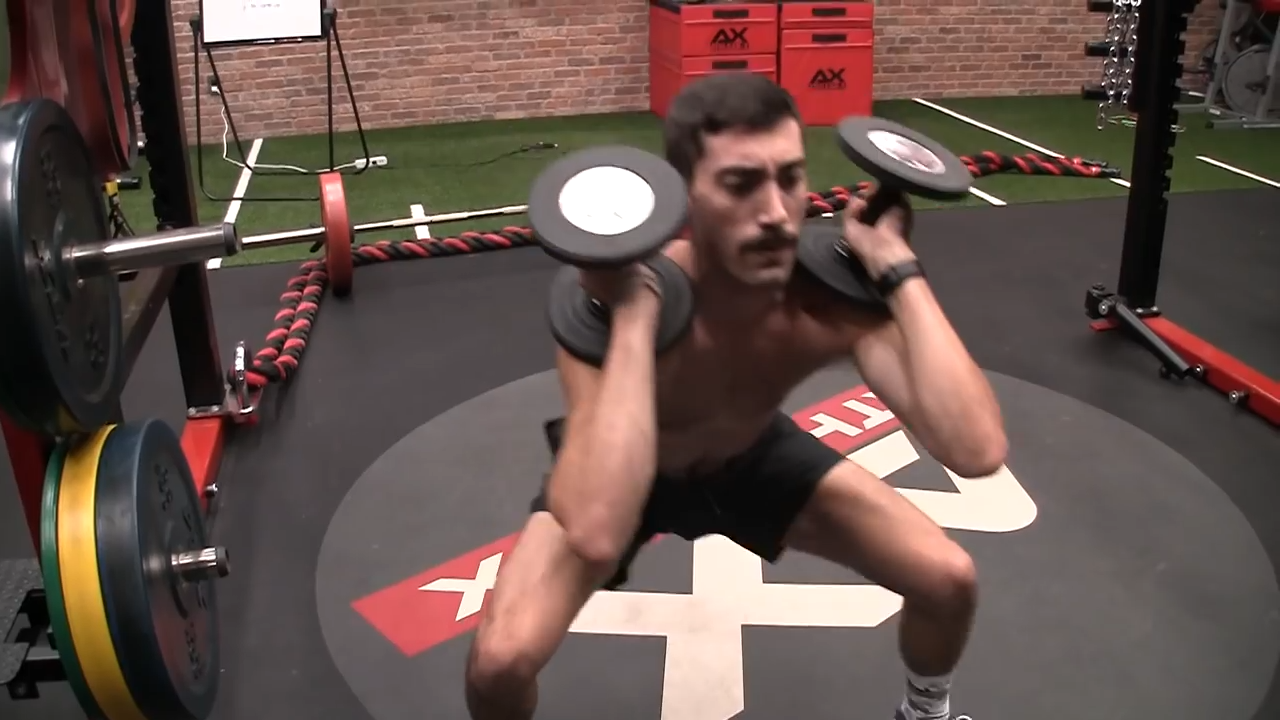
HOW TO DO THE WALK THE BOX:
- Hold two light dumbbells in the front rack position.
- Squat down so that your thighs are parallel with the ground.
- Maintain this position with proper form and good thoracic extension through your upper back as you walk around, creating the shape of a box.
WHAT MAKES IT EFFECTIVE: I love this exercise because it’s a three-dimensional movement metabolic powerhouse. I guarantee this one is going to burn.
TOTAL BODY: DUMBBELL SQUAT CLEAN
If you’re short on time and looking to get the most bang for your bodybuilding buck, the Dumbbell Squat Clean is the exercise to do.

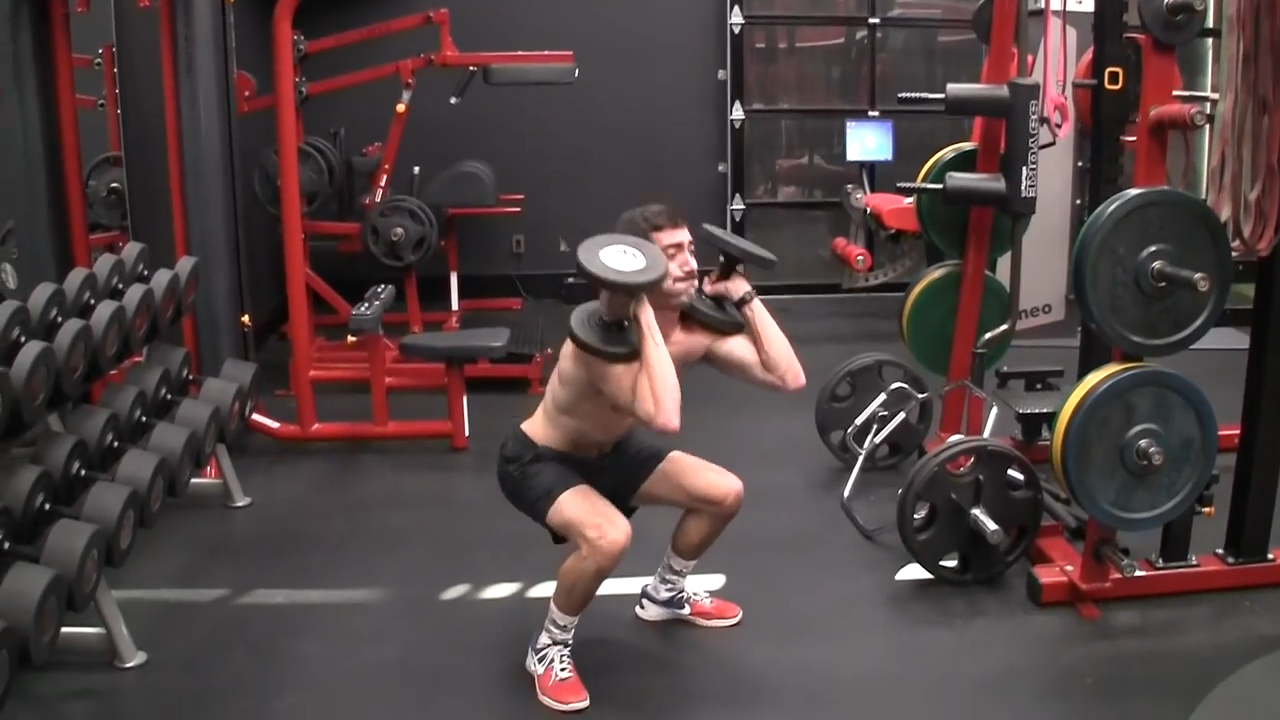
HOW TO DO THE DUMBBELL SQUAT CLEAN:
- Start in a Deadlift position by bending your knees and holding two dumbbells on the floor.
- Explosively clean the dumbbells up to your shoulders into a front rack position.
- Try to match up your stomp with the catch of the dumbbells onto your shoulders. This will help with proper timing and performance.
- If you’re looking for that extra challenge, you can add an overhead press.
WHAT MAKES IT EFFECTIVE: The Dumbbell Squat Clean is a power-based movement that targets several major muscle groups. When you throw in an Overhead Press, you incorporate the upper body in a more direct way.
CORRECTIVE: GOBLET ADDUCTOR LUNGE
I say it all the time: Most people are so busy with squats and lunges that they completely ignore the adductor complex.
These are the five muscles on the inside of your legs that are not only going to provide stability to your pelvis but assist you in standing up from the bottom of a squat.
The Goblet Adductor Lunge is one of my favorite dumbbell leg workouts to target the adductor muscles.

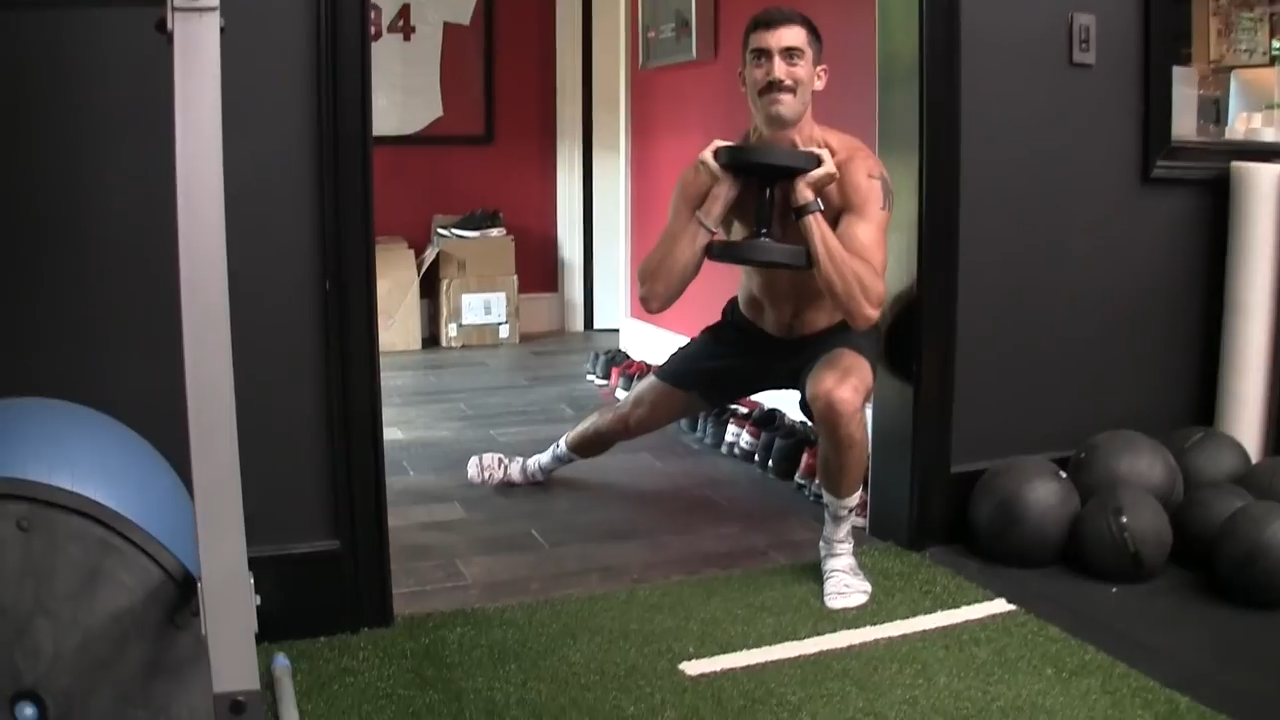
HOW TO DO THE GOBLET ADDUCTOR LUNGE:
- Before entering the initial position, select a dumbbell that is lighter but still challenging.
- Starting position is holding the dumbbell with both hands, place one foot on a surface where you can slide and keep the other foot on a stable surface. For example, you can put one foot on a hardwood floor and the other foot on carpet.
- Slide the foot out as you drop down into a lateral lunge position.
- Shift all your weight to the other leg. Now, squeeze and shorten those adductors to get yourself back up to the original position.
WHAT MAKES IT EFFECTIVE: It directly targets the adductors in a big way, strengthening a muscle that most people forget about. It also challenges strength and balance.
MISCELLANEOUS: OFFSET DUMBBELL LUNGE
This final exercise doesn’t really fit into any of the other goal categories I listed above, but I still find it incredibly useful.
The Offset Dumbbell Lunge targets the glute medius, which I believe is just as overlooked and underworked as the adductor complex.


HOW TO DO THE OFFSET DUMBBELL LUNGE:
- Hold a dumbbell in your left hand, and then lunge forward with the right foot.
- Since the weight has been placed in the opposite hand and you’ve stepped out with the other leg, you’re going to feel the weight pull you in that direction. This is when the gluteus medius activates to pull you back, get you level, and prevent you from falling.
- Repeat on the other side.
WHAT MAKES IT EFFECTIVE: The counter balance ensures the glute medius is going to fire and get stronger.
If you’re looking for more great exercises to add to your dumbbell leg workouts, you can check out my article on Best Dumbbell Exercises for Legs to see more examples.
8) HOW TO DO LEG WORKOUTS AT HOME
What about those of you who are working out from home? Is there an at-home leg workout that can help you achieve those fitness goals of size and strength, even if you don’t have access to weights?
You bet.
But before I get into leg workouts at home, I want to address a commonly asked question: Is it worthwhile to do leg workouts without weights?
ARE HOME LEG WORKOUTS EFFECTIVE?
I know a lot of people are leery about leg training at home. I can’t tell you how many people ask me,
“How can I strengthen my legs at home?”
And when I say that they don’t need any weights, I get looks of disbelief.
Despite whatever preconceived notions you might have about calisthenics, here’s the bottom line: It IS possible to build strong and muscular legs from the comfort of your own home.
The trick is altering your intensity.
When you’re in the gym, you have plenty of weight to help you crank up that intensity.
But when you’re at home working out, you might not have that same luxury – in fact, you might not even have a set of resistance bands for resistance band leg workouts.
So, what can we do about that?
We can increase the intensity of the exercises to produce the same effect that you’d get with heavy weights.
And that’s exactly what I’m going to teach you to do in this bodyweight leg workout. And guess what: You don’t need any equipment.
BODYWEIGHT LEG WORKOUT WITH NO EQUIPMENT
I’ve designed these at home leg workouts to be extremely functional AND practical. You can literally do every exercise in the comfort of your own living room.
You can even use it when you’re on a trip away from home and you want to keep up with your leg training programs (which you always should!).
Prepare to set aside 20 minutes for this circuit-style workout.
Just because it might be a fraction of the time of your normal workouts doesn’t mean it is going to be easy.
This challenging workout is going to hit it all. Here’s a complete breakdown of what you’ll be doing including your rest periods.
- Anterior Chain – Bodyweight Squats
- Posterior Chain – Bridge Marches
- Explosive – Bodyweight Swings
- Rest 30 seconds
- Corrective 1 – Jane Fondas x 30 seconds each leg
- Corrective 2 – 1 1/2 Rep Adductor Slides x 30 seconds each leg
- Rest 30 seconds
Complete this circuit four times, giving yourself 30 second, shorter rest periods between each round.
BODYWEIGHT SQUAT


HOW TO DO THE BODYWEIGHT SQUAT:
- For foot position, start with your feet hip width apart.
- Kick your hips back and perform a deep squat.
- Squeeze the glutes to return to the start.
WHAT MAKES IT EFFECTIVE: The Squat is the ultimate lower body exercise that targets every major muscle group.
BRIDGE MARCH

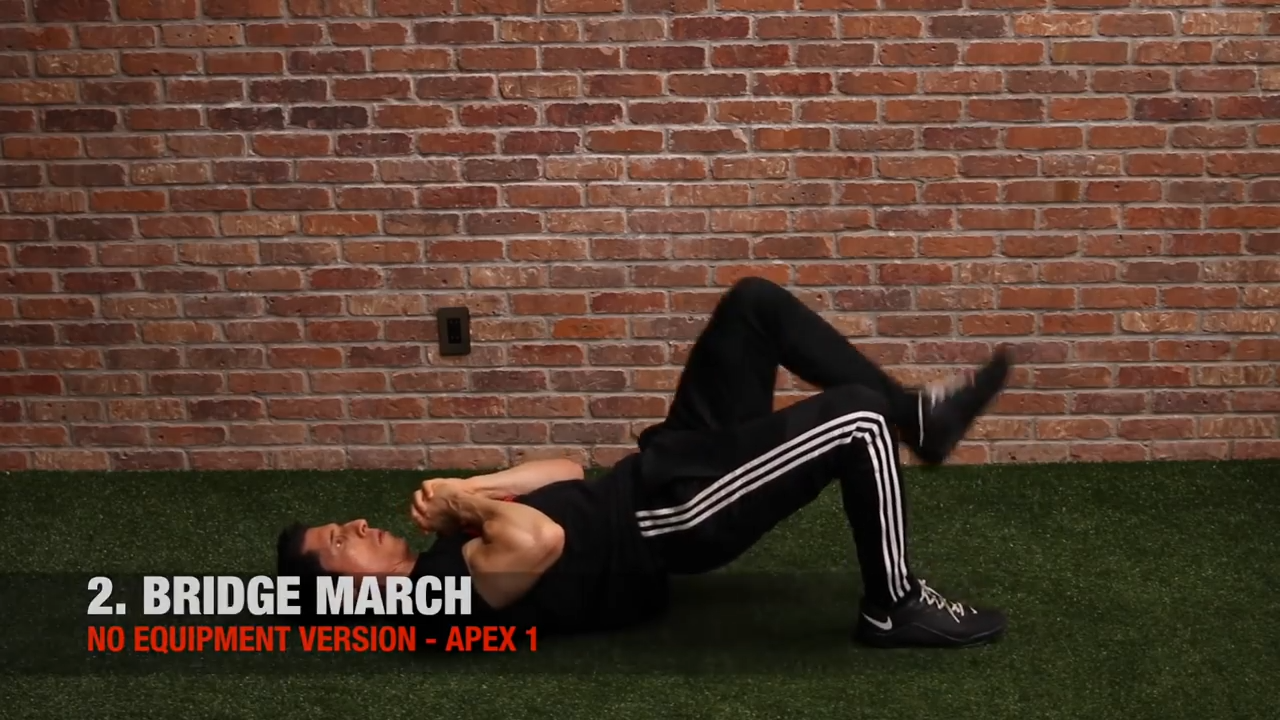
HOW TO DO THE BRIDGE MARCH:
- Lie on a comfortable surface.
- Squeeze your glutes and lift your hips up into Glute Bridge position.
- Keep your feet flat on the floor as you bring your left leg up with knees bent then lower it back down, maintaining that Bridge pose.
- Now lift your right leg.
- Continue alternating.
WHAT MAKES IT EFFECTIVE: I’m often asked, “Are squats enough for glutes?” They’re good, but you can do yourself one better. The Bridge March is one of my favorite exercises because it directly targets the glutes and hamstrings.
BODYWEIGHT SWING

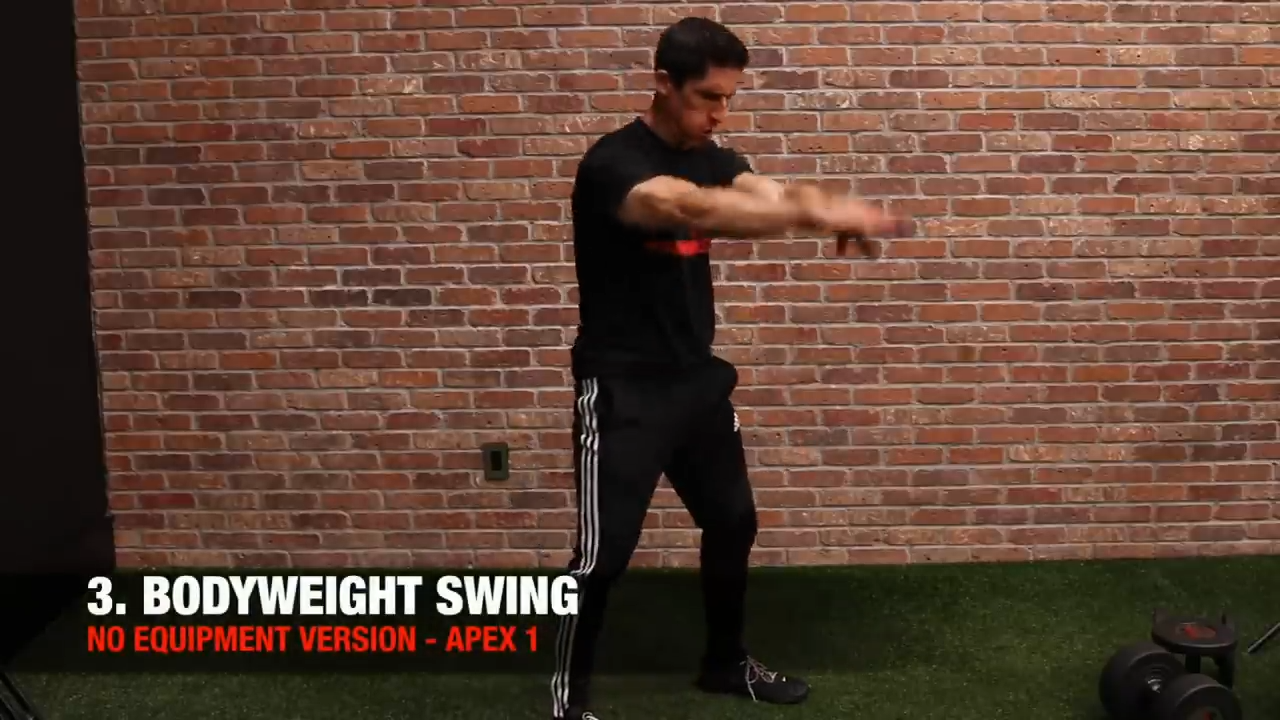
HOW TO DO THE BODYWEIGHT SWING:
- Stand with your feet hip width apart.
- Bring the arms up and then swing them down in between your legs just like you would do with a Kettlebell Swing.
- Squeeze the glutes and swing your arms back up.
WHAT MAKES IT EFFECTIVE: This explosive bodyweight version of the Kettlebell Swing reinforces the same hip hinge pattern.
JANE FONDAS

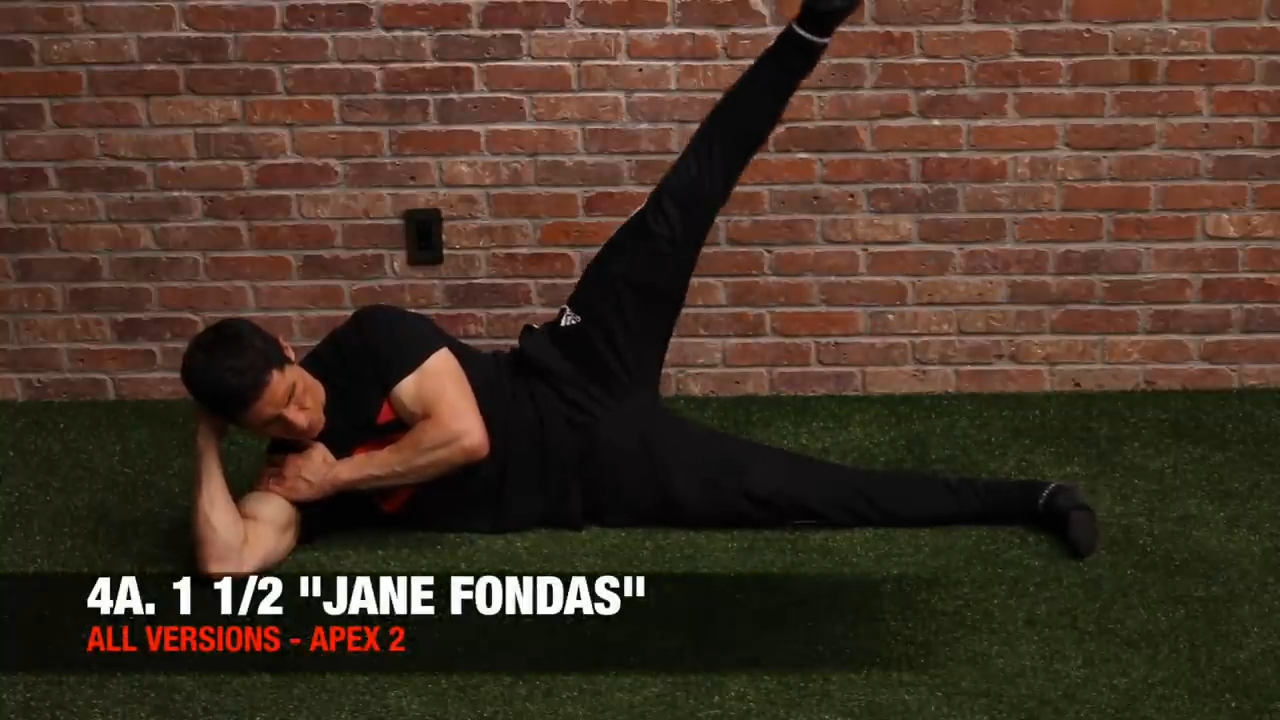
HOW TO DO JANE FONDAS:
- Lie on your right side and bring your left leg straight up in the air.
- Be sure to keep your left knee straight.
- Bring the leg down and up, continuing to perform leg raises.
- Switch legs and repeat on the other side.
WHAT MAKES IT EFFECTIVE: You know I’m a big fan of targeting the often-forgotten abductors and adductors, and this corrective exercise helps to strengthen both.
1 ½ REP ADDUCTOR SLIDES

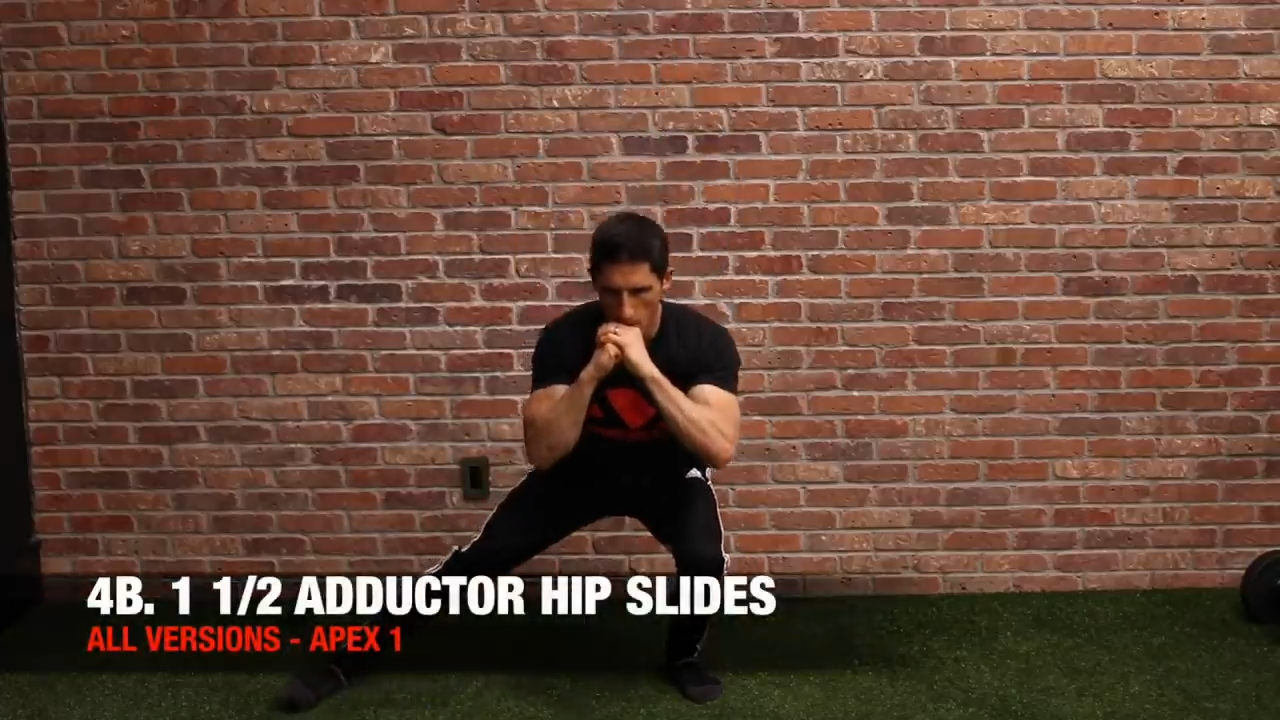
HOW TO DO 1 1/2 REP ADDUCTOR SLIDES:
- Stand with your feet shoulder width apart.
- Slightly bend the left knee and begin sliding your left foot away from your body.
- Pause once you are in a lateral lunge position with the knee bent slightly.
- Slide back up halfway, pause, and then slide back down to the lowered lateral lunge position.
- Now return all the way to the top. That’s one rep.
- Repeat on the other side.
WHAT MAKES IT EFFECTIVE: This exercise is going to bulletproof your adductors, which will translate into better performance during other exercises like squat training and deadlifts or Romanian deadlifts.
Want even more at home workouts for legs? Check out my article Bodyweight Leg Workout.
By now you should be convinced that building bigger, stronger, muscular legs is a must for your training program.
Having a respectable set of legs has benefits both for functionality and the look of your overall physique.
And don’t forget that the knees are also one of the most important joints for all lower body exercises!
Give the techniques and exercises in this guide a try, and you’ll be surprised by just how quickly your legs will improve, both in your workouts and in daily activities.
If you’re looking for a complete plan to build lean muscle and strength in every muscle group in the body, see which of our ATHLEAN-X programs best suits your goals and equipment possibilities.
LEG WORKOUTS FAQS
The best leg workout targets all the leg muscles, hits every primary function of the legs and works the legs through all three planes of motion. Here are some of the best leg exercises to include in the workout:
- Barbell Squats
- Barbell Hip Thrust
- Bulgarian Split Squat in Hi-Low Fashion
- Bodyweight Plyo Bulgarian Split Squats
- TKE Drop Lunge
- Dumbbell Goblet Adductor Lunge
- Hip Band Ladder
These exercises will help you achieve leg muscle growth, explosive power and stronger muscles.
Three exercises that will help strengthen the legs are:
The best way to train your legs at home for muscle size is using bodyweight only. Here are the 5 best at home bodyweight leg exercises:
You shouldn't train your legs daily because muscles need adequate rest time to recover and repair between training sessions. Training legs just 1-2 times per week helps avoid muscle soreness and risk of injury. It is in this recovery period that the growth actually takes place. You need at least one day fully dedicated to leg training, but optimally, you’ll hit your legs two times per week.
Five exercises may not be enough for building strength in the legs and for leg muscle growth. The best leg workout targets all the leg musculature, hits every function of the legs and works the legs through all three planes of motion. Here are some of the best leg exercises to include in the workout:
REFERENCES

Jeff Cavaliere M.S.P.T, CSCS
Jeff Cavaliere is a Physical Therapist, Strength Coach and creator of the ATHLEAN-X Training Programs and ATHLEAN-Rx Supplements. He has a Masters in Physical Therapy (MSPT) and has worked as Head Physical Therapist for the New York Mets, as well as training many elite professional athletes in Major League Baseball, NFL, MMA and professional wrestling. His programs produce “next level” achievements in muscle size, strength and performance for professional athletes and anyone looking to build a muscular athletic physique.

















